FLAMINGO, Florida (AP) - Grabbing a clump of vegetation to steady herself, Tiffany Troxler gingerly slides her feet along the makeshift boardwalk as she ventures out into the marsh. The boards sag, dipping her up to her knees in the tea-colored water.
"This is the treacherous part," the Florida International University researcher says. "The water levels are up."
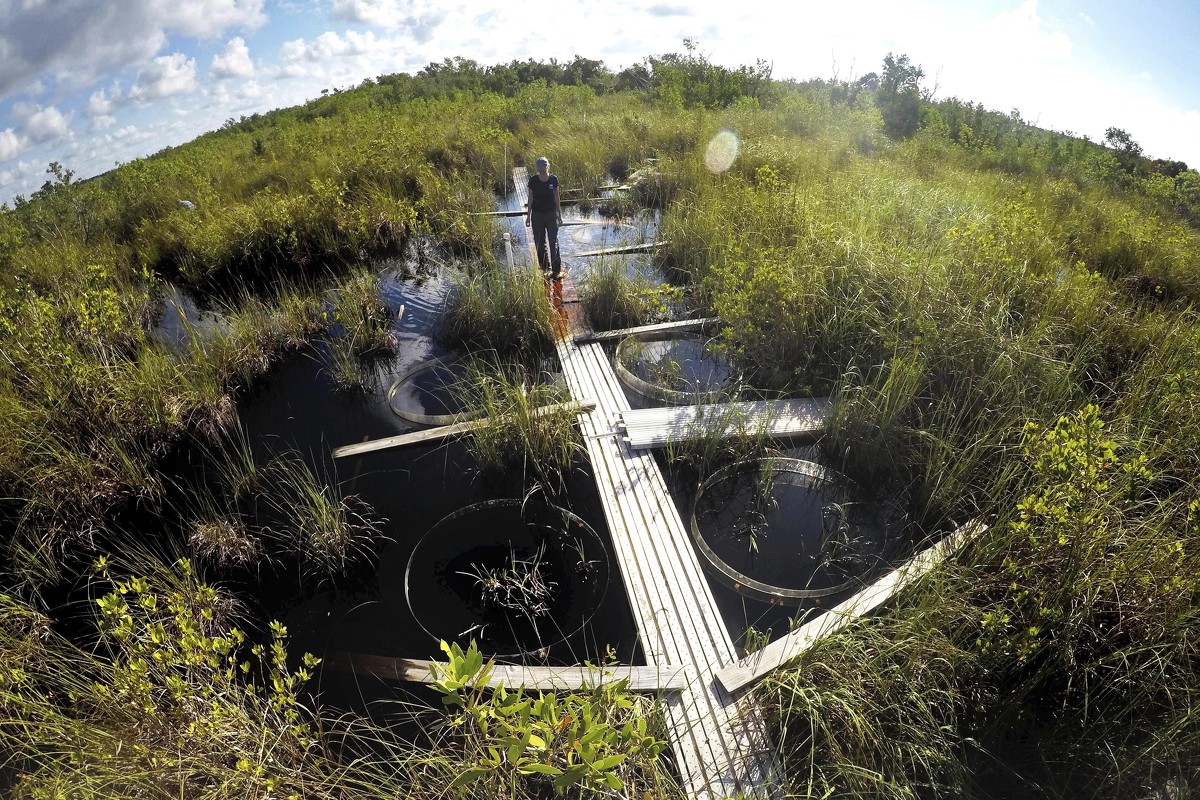
In this Monday, Oct. 21, 2019 photo, Tiffany Troxler, research scientist and professor at Florida International University walks on a boardwalk at a wetlands research site at Everglades National Park near Flamingo, Fla. She's studying wetlands ecosystem and its relation to sea-level rise. (AP Photo/Robert F. Bukaty)
To a layman, this patch of brown-green saw grass and button mangrove deep inside Everglades National Park looks healthy enough, but Troxler knows trouble lurks just beneath the murky surface. She points to a clump of grass: Beneath the water line, the soil has retreated about a foot, leaving the root mass exposed. It is evidence that the thick mat of peat supporting this ecosystem is collapsing - and research suggests encroaching sea water is to blame.
"You can think about these soils as your bank account," says Troxler, associate director of FIU's Sea Level Solutions Center. "In the condition that this marsh is right now, the outlook is not good."
Formed roughly 5,000 years ago, during a time of sea level rise, the Everglades once comprised an area twice the size of New Jersey.
"The miracle of the light pours over the green and brown expanse of saw grass and of water, shining and slow-moving below, the grass and water that is the meaning and the central fact of the Everglades of Florida," journalist and activist Marjory Stoneman Douglas famously wrote in 1947. "It is a river of grass."
But over the course of just the last century, about half of the Everglades' original footprint has been lost - plowed under or paved over, never to be recovered, so long as South Florida's 8 million human inhabitants claim it for their homes, livelihoods and recreation.
The glades have been sapped by canals and dams that remapped the landscape and altered animal habitats, polluted by upstream agricultural areas, transformed by invasive species. And now, rising sea levels - this time, caused by man - threaten to undo what it took nature millennia to build.
What survives is not so much a natural ecosystem, but a remnant, heavily dependent on - and at the mercy of - a network of more than 2,100 miles of canals, 2,000 miles of levees and hundreds of floodgates, pump stations and other water-control structures.
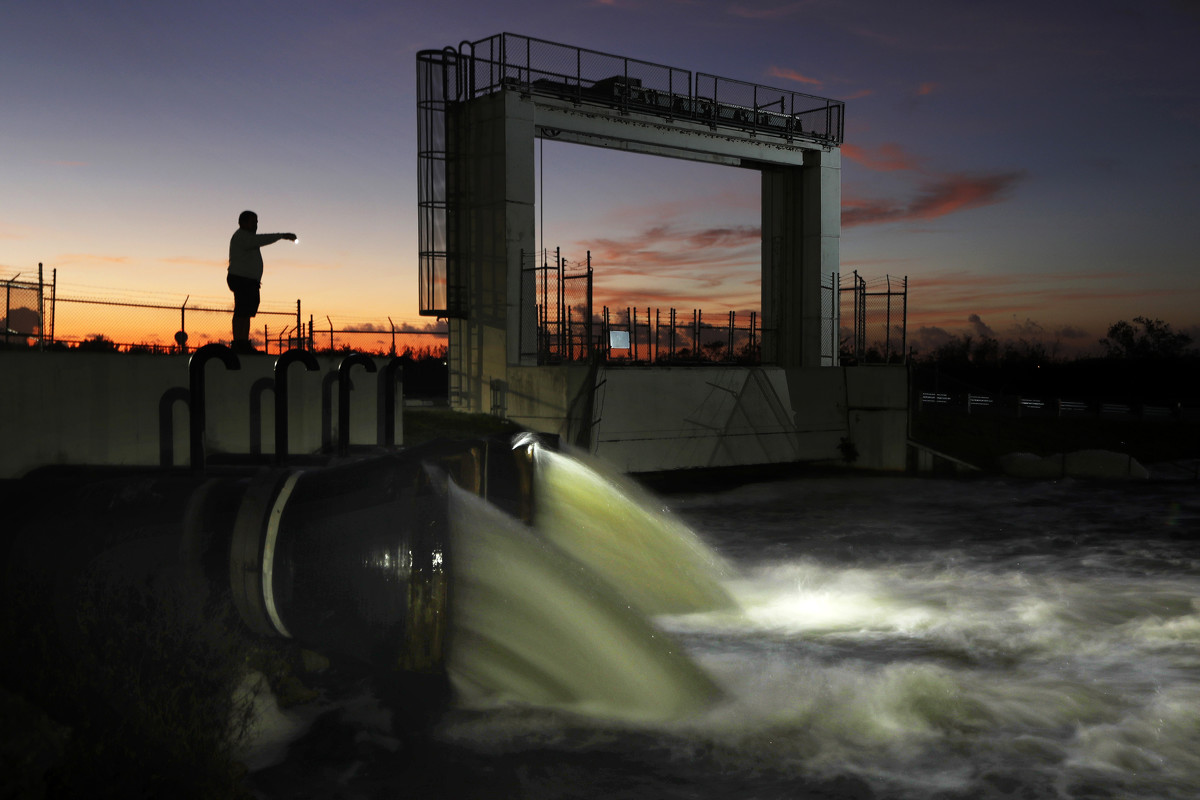
In this Monday, Oct. 28, 2019 photo, water is discharged from a flood control station along the Tamiami Trail in Miami, Fla., into a canal that drains into Everglades National Park. Heavy rains that often flood a conservation area north of the station trigger flushing of the canal, raising environmental worries about the quality of water flowing into the park. (AP Photo/Robert F. Bukaty)
What the Army Corps of Engineers calls a "highly managed system," others have sardonically labeled a "Disney Everglades."
Nearly two decades and $4 billion into the Comprehensive Everglades Restoration Plan, an ambitious federal-state program adopted in 2000, new data about the pace of climate change have called into question how much of the Everglades can ever be salvaged - and what that even means.
"I tend to think that everything can be saved," says Fred Sklar of the South Florida Water Management District, which monitors and runs much of the Everglades' infrastructure. "Restored is another question."
___
"Here are no lofty peaks seeking the sky, no mighty glaciers or rushing streams wearing away the uplifted land," President Harry S. Truman said in a 1947 address dedicating Everglades National Park. "Here is land, tranquil in its quiet beauty, serving not as the source of water, but as the last receiver of it. To its natural abundance we owe the spectacular plant and animal life that distinguishes this place from all others in our country."
At the center of it all was Lake Okeechobee, the Everglades' 730-square-mile "liquid heart."
Today, we understand that natural systems like the untouched Everglades provide enormous benefits - water filtration, nurseries for fish and other wildlife, protection from storm surges, even carbon sequestration. But to 19th-century Floridians, all that water - and the mosquitoes and reptiles it harbored - represented an impediment to progress.
And so when Florida became a state in 1845, one of the Legislature's first acts was to pass a resolution asking Congress to survey the "wholly valueless" Everglades "with a view to their reclamation."
Beginning in earnest during the 1880s, a host of entities set about draining the swamp. They dug canals east and west from Lake Okeechobee, carrying nutrient-laden water that altered the salinity of coastal estuaries and caused toxic algae blooms. They seeded the wetlands from the air with a thirsty, paper-barked Australian tree called melaleuca. The vast custard apple forest that girded the lake's southern shore was torched, burning so fiercely that it set the very earth on fire.
Peat soils that had accumulated over thousands of years dried up and blew away. The result: At the University of Florida Research Station in Belle Glade, a concrete marker driven through the organic soil down to the limestone substrate shows the ground has sunk 6 feet since 1924.
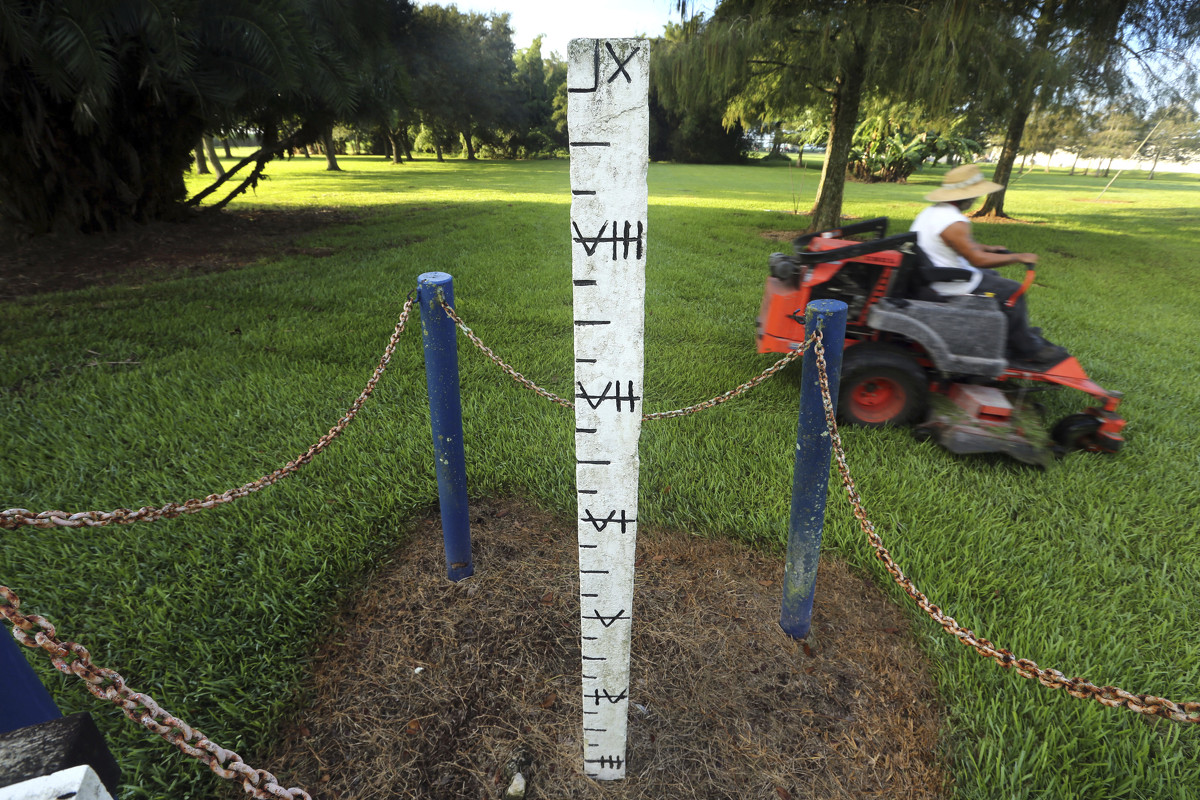
In this Friday, Nov. 1, 2019 photo, a subsidence post marks more than 6 feet of peat soil loss since the post was driven into the ground in 1924 at the University of Florida Everglades Research Center, in Belle Glade, Fla. The amount of peat lost has had ongoing implications for restoration and habitat recovery for the Everglades. (AP Photo/Robert F. Bukaty)
And still, the tinkering went on.
In the 1960s, the Corps began straightening the meandering, flood-prone Kissimmee River. Lined by wetlands so lush that they were known as "the Little Everglades," the shallow, 130-mile river was what one wildlife expert called a "nursery ground for sport fishes." By 1971, engineers had straightened the once free-flowing stream into a 56-mile, 30-foot-deep canal bureaucratically designated as the C-38.
But it was an event in 1928 that, as much as any, altered the Everglades' course. That year, a hurricane overwhelmed the flimsy dike along Lake Okeechobee's southern shore, causing a deluge that killed 3,000 people, most of them poor, black farmworkers. The resulting 143-mile, 30-foot-high Herbert Hoover Dike now nearly completely surrounds the lake, permanently severing its connection to the park.
The Corps' primary mandate was to protect people, not the environment. As the narrator put it in the 1950s documentary "Waters of Destiny," the agency saw itself as victorious in a war against nature:
"Water that once ran wild. Water that ruined the rich terrain. Water that took lives and land. Put disaster in the headlines and death upon the soil. Now, it just waits there. Calm, peaceful. Ready to do the bidding of man and his machines."
Scientists estimate that more than 650 billion gallons of fresh water a year once flowed south into what is now Everglades National Park. Today, that flow is about 280 billion gallons.
Flash forward to the present day, when many of the same canals and levees and pumps that helped drain the Everglades are now being used to try to save them. Alongside the Everglades Agricultural Area, the 700,000-acre checkerboard of sugar cane and winter vegetable fields south of Lake Okeechobee, huge tracts are being converted to store and clean water for use when and where it is needed.
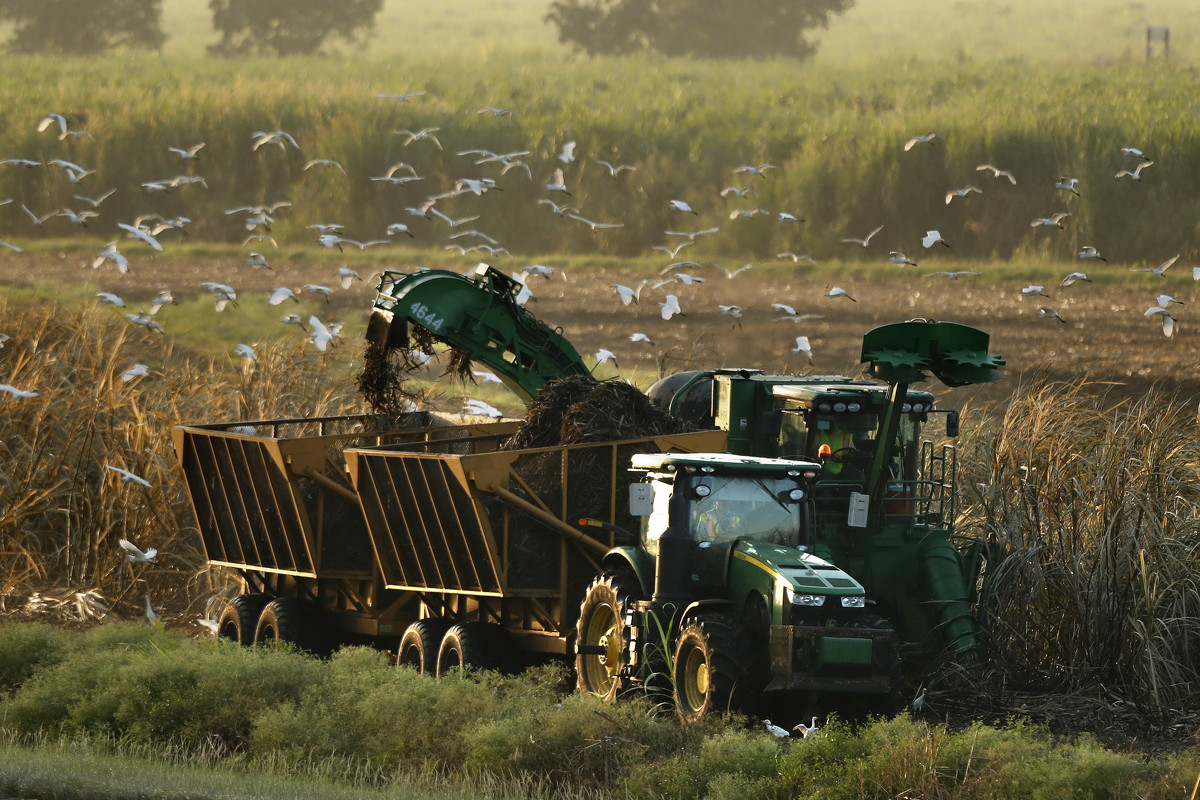
In this Friday, Oct. 25, 2019, photo, sugar cane is harvested, attracting cattle egrets in search of insects, near South Bay, Fla. Much the original Everglades wetlands have been drained to create agricultural land, depriving the ecosystem of its natural water flow. (AP Photo/Robert F. Bukaty)
Perhaps the biggest step toward that end so far is the re-engineering of Tamiami Trail, the east-west highway that essentially has acted as a dike through the heart of the Everglades since the 1920s. Since 2013, workers have elevated 3.3 miles of the roadway, allowing water to flow freely into Shark River Slough, historically the deepest and wettest part of the Everglades.
"We're starting to see the vegetation respond, and we're getting more of those marsh grasses, more of those open water sloughs," says Stephen Davis, senior ecologist with the Everglades Foundation. "I'm very confident that we can restore this ecosystem. And by restoration, I mean enhancing the functionality of what remains."
"We're on the threshold of seeing whether the previous 20 years of work will pay off," says William Nuttle, a consultant with the University of Maryland's Center for Environmental Science who began his career in the marshlands of South Florida.
But time is not on the Everglades' side.
Over the past decade, scientists began noticing an alarming trend in the wetlands near the park's southwest tip - "potholes" of open water filled with dead vegetation. Sea water, Nuttle says, was causing vast areas of once-healthy saw grass prairie "to unravel like a moth-eaten wool sweater."
A lack of fresh water from the north and the intrusion of sea water have boosted salinity levels in the marshes, Troxler and others say, which appears to be hindering plant growth.
Scientists are counting on mangroves and other more salt-tolerant plants to migrate inland into the saw grass plains, establishing a new, natural bulwark against climate change. But that change may already be outpacing nature's - and man's - ability to counter it: When the restoration plan was adopted in 2000, its authors were anticipating seas to rise only 6 inches by 2050. They've since already risen 5 inches.
In its most recent report to Congress, a panel of the National Academies of Sciences, Engineering, and Medicine urged a sweeping reassessment of restoration projects, warning that the current work is lagging behind the pace of climate change and could take 65 years to complete at the current funding levels.
"At this pace of restoration, it is even more imperative that agencies anticipate and design for the Everglades of the future," they wrote.
___
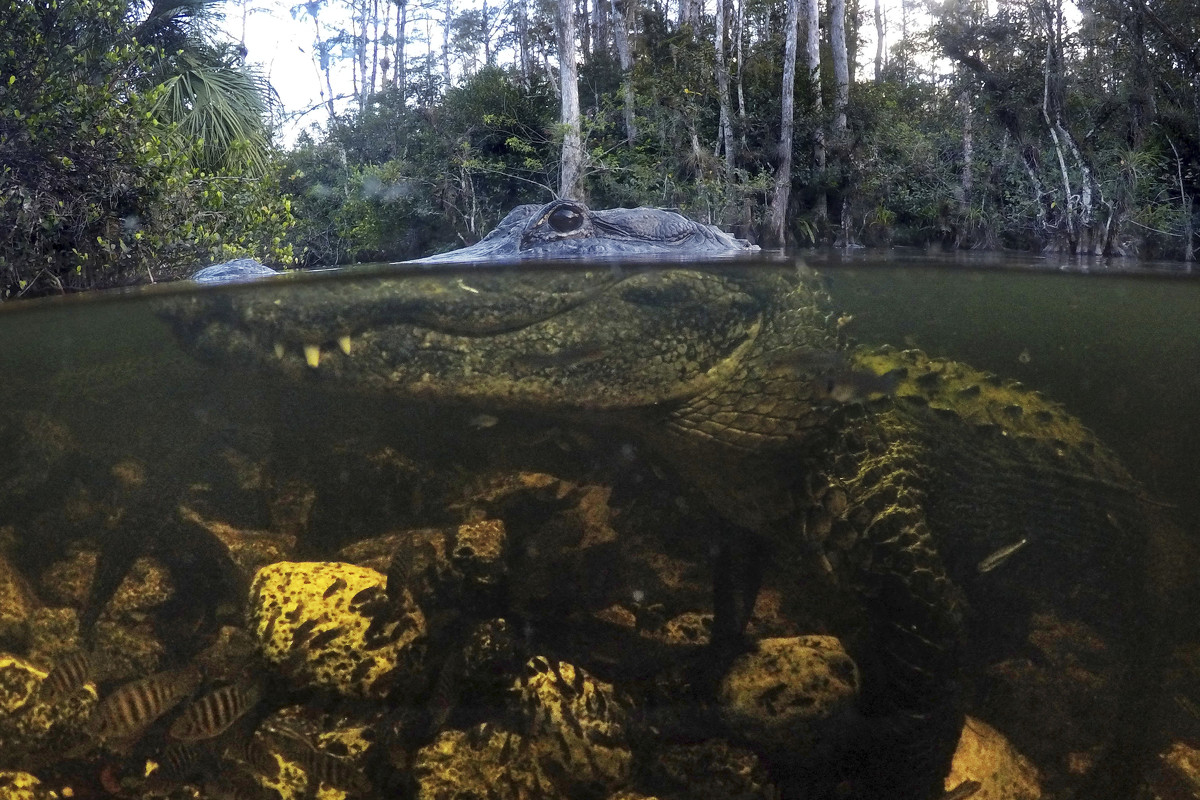
In this Wednesday, Oct. 30, 2019, photo, an alligator prowls the waters in the Big Cypress National Preserve in Florida. Formed roughly 5,000 years ago, ironically enough, during a time of sea-level rise, the glades once comprised an area twice the size of New Jersey. (AP Photo/Robert F. Bukaty)
Everglades National Park is home to a stunning array of wildlife.
There are more than 360 species of birds, including the great blue heron and the diminutive green variety, purple gallinules and roseate spoonbills, the white ibis and the black skimmer. It is said to be the only place in the world where freshwater alligators and saltwater crocodiles co-exist.
And then there are the non-native species that are throwing off nature's balance.
On a blisteringly hot late-October morning, wildlife biologist Ian Bartoszek, who heads the Conservancy of Southwest Florida's snake research and removal program, sloshes through a cypress swamp outside Naples.
Holding an H-shaped antenna aloft in his right hand, he listens as the signal from the device in his other hand steadily increases. "As the beeps get louder, the giant snake is getting closer," he says.
Of all the invasive species plaguing the Everglades, the Burmese python is the most high-profile and, arguably, the most intractable. No one is quite sure how a giant snake native to Southeast Asia found its way into the wilds of South Florida in the late 1970s, although many believe the first were escaped - or released - pets. Estimates of their population run into the hundreds of thousands, and they are voracious.
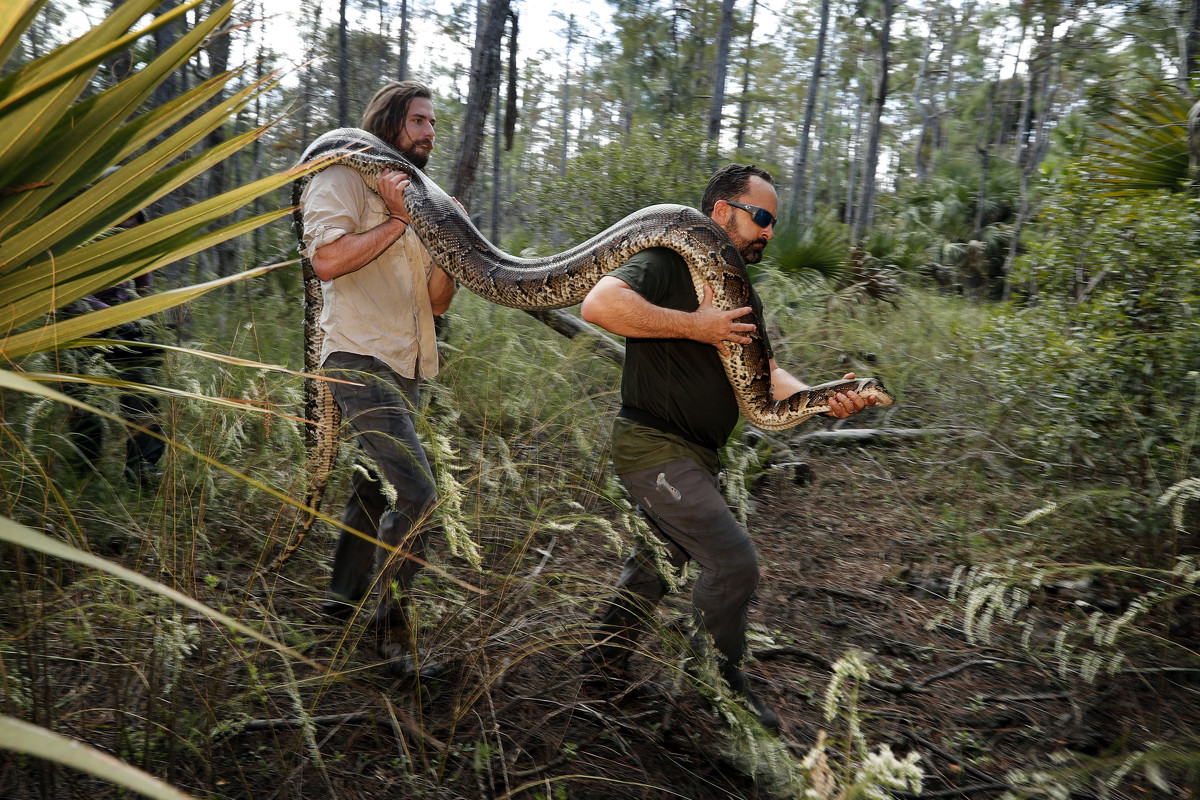
In this Wednesday, Oct. 23, 2019, photo, Ian Bartoszek, right, and Ian Easterling carry a 14-foot, 95-pound, female Burmese python out of an upland habitat in Naples, Fla. A male python fitted with a radio transmitter implant led them to the female a couple yards from an upscale housing development. (AP Photo/Robert F. Bukaty)
In 2015, Bartoszek's team captured a 31.5-pound female in the process of digesting a 35-pound fawn. In all, the conservancy and its research partners have documented the remains of 23 species of mammal and 43 species of birds in the pythons' bellies.
Scientists suspect the python is responsible for the disappearance of up to 99 percent of the marsh rabbits, raccoons and other small mammals in the national park.
Pythons can remain underwater for as long as a half-hour, and their black, brown and tan pattern helps them blend into both the marsh and higher sandy ground. All of which makes them almost impossible to find. So, since 2013, Bartoszek has been using pythons to catch pythons.
Every two weeks, he flies over the area, picking up the unique signal of radio transmitters surgically implanted into 25 snakes and plugging their coordinates into a spreadsheet. The hope is that these so-called "Judas snakes" will lead them to others, especially breeding-age females.
This day, they've picked up the signal of Python No. 21 - a 50-pound, 11-and-a half-foot male named Johnny Rebel who has helped find 20 adult pythons, including eight females carrying approximately 560 developing eggs.
"He's an MVP," Bartoszek says with a grin. "Our most valuable python."
Bartoszek straps on a machete and, with a nod to Sherlock Holmes - "The game is afoot!" - plunges into the woods. Following deer paths, he and field technician Ian Easterling step over old barbed-wire fences and downed melaleuca trees as the receiver leads them deeper into the brush. The beeping intensifies.
"We're getting warmer," Bartoszek says. "This looks snaky right here. This is where I would be."
"I see a head here!" Bartoszek shouts a few moments later. "Confirm!"
"There's a snake moving here," Easterling replies. Diving into the undergrowth, Bartoszek does a double-take: "Hold on a second. … There might be two pythons!"
Johnny, it seems, has found a girlfriend.
After catching their breath, he and Easterling plunge their heads into the thicket, where the fat reptile is coiled up - and staring right at Easterling. "Hi!" he says. "Don't strike out!"
Easterling grabs the tail as Bartoszek clamps a hand around the snake just behind the head. She is shedding, making it difficult to establish a grip.
"Here comes the pretzel move," he shouts as the giant reptile writhes, flopping against his thigh with a thud. With a deep groan, she lets go the contents of her digestive tract.
The fight is over.
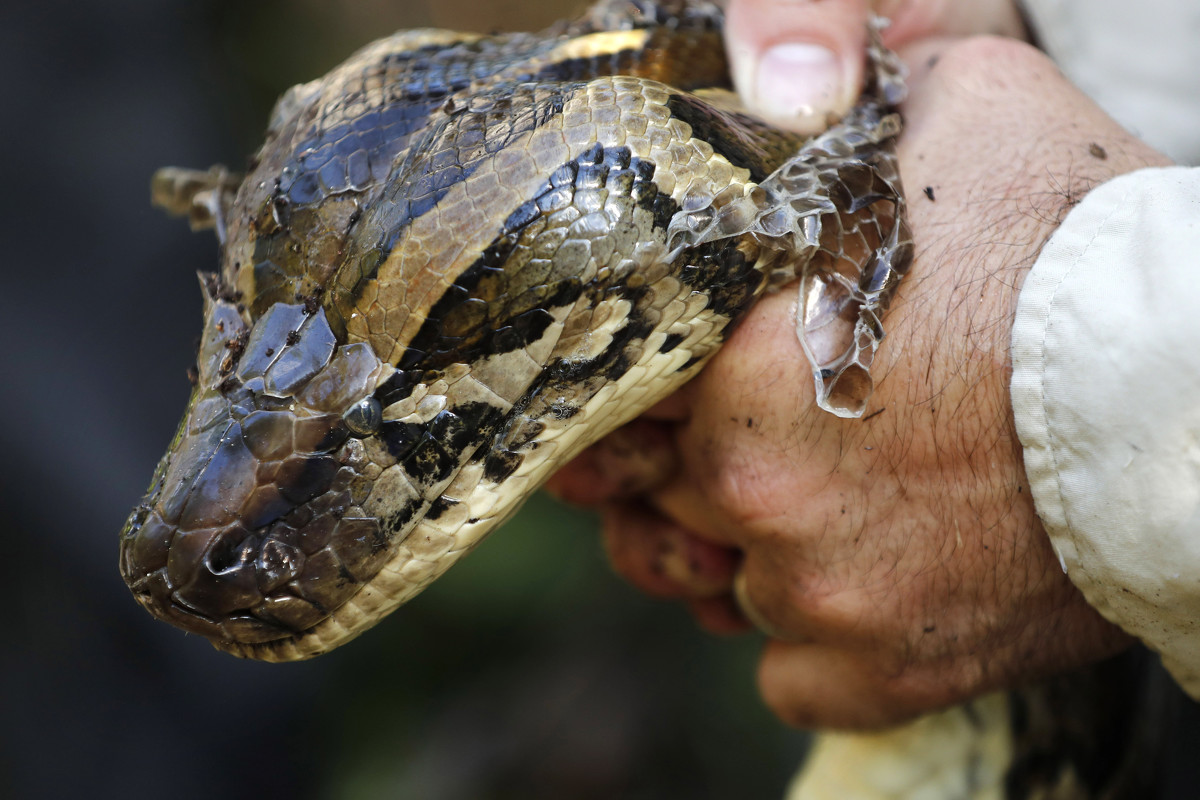
In this Wednesday, Oct. 23, 2019, photo, a 14-foot, 95-pound, female Burmese python is held tightly by wildlife biologist Ian Bartoszek after he captured it in Naples, Fla. The snake was in the process of shedding a layer of skin, making handling the creature especially challenging. (AP Photo/Robert F. Bukaty)
Back in the lab, they weigh and measure their prize: nearly 14 feet long and just over 95 pounds. After putting her in a case and locking her in a storeroom, Bartoszek sifts through her droppings, finding bits of bone and what turn out to be the hooves of a white-tail deer - the primary prey of the Florida panther, an endangered native species.
"It feels like `CSI Crime Scene' here in this lab sometimes," he says. "It's the smoking gun, what's going on out there in the Everglades."
In the past six years, the conservancy team has removed more than 500 pythons with a combined weight of about 13,000 pounds from a 50-mile-square area. Despite that success, Bartoszek thinks that total eradication of the Burmese python "is off the table."
"It seems to be adapting and evolving real time here in the Everglades ecosystem," he says. "It may be more appropriate to start referring to them as the Everglades python. Because they're ours now. They're here."
----
When the Everglades restoration plan was adopted in 2000, it aimed to turn back the clock to the pre-drainage wilderness of Douglas' imagination. But in the face of rising seas, along with fluctuating temperatures and rainfall distribution, experts agree there is no going back.
"Everglades restoration has always been an ambitious and complex endeavor," the National Academies of Sciences panel wrote. "Our current review emphasizes how it is also dynamic and the importance of focusing restoration on the future Everglades, rather than on the past Everglades."
Earlier this year, an interagency group that includes the Corps of Engineers and the National Park Service issued its latest Everglades System Status Report - and it was not cheery.
"Overall, the Florida Everglades is struggling to survive in the face of sustained pressure from human activities and the increasing impacts of climate change," the group wrote. "The poor to fair scores reflected in the report card indicate that the region's ecosystems are degraded and the anticipated ecological benefits of restoration are still to be realized."
Still, there are some hopeful signs.
Some adaptation is taking place. Scientists poking through the bellies of wood storks, an "indicator species" for Everglades restoration, have found evidence that they are feasting on the non-native African jewelfish. And the endangered Everglades snail kite is showing a fondness for an exotic species of the mollusk, another latecomer to the region.

In this Friday, Nov. 1, 2019 photo, an endangered snail kite flies with an apple snail at Lake Kissimmee in Kenansville, Fla. Water level control and the resulting loss of wetlands has caused the population to drop to about 400 breeding pairs. (AP Photo/Robert F. Bukaty)
Perhaps the most encouraging development of all is the ongoing $578 million project to restore 40 square miles of the Kissimmee River Basin. Since the demolition of some of the dams, a portion of the river has found its old channel. The wetlands are returning, and so is the wildlife.
Thomas Van Lent, vice president of science and education at the Everglades Foundation, recently took a pontoon boat trip on a 2-mile section of the restored river.
"And there were snail kites everywhere," he says. "It's just amazing to see the effects."
His colleague Stephen Davis believes the plan can provide flood protection - and water for drinking and recreation - while restoring and preserving the Everglades' original functions.
"I think there are some that think restoration is like restoring an old automobile back to what it looked like and felt like historically," he says. "That's not the case with Everglades restoration."
In 2015, the Corps submitted its most recent report to Congress, estimating the total cost of restoration at $16 billion - about twice the original projection. Unsurprisingly, that figure draws detractors who question such a large outlay being spent with no guarantee of success.
One recent steamy morning, Michael Todd Tillman watched as three massive pumps, running around the clock since spring, spewed water into the L-29 Canal beside the Tamiami Trail at a rate of 250 cubic feet per second.
"They're about to flood me out," says the airboat operator, whose family has a recreational camp inside the park.
Tillman says he understands what the engineers are trying to do, but wonders whether he and others could be losing a way of life based on someone's best guess.
"They made huge mistakes before," he says. "How do they know this is the right answer now?"
Whatever the final price tag, Nuttle says humans created this "hybrid ecosystem" and that it is up to humans to maintain it - for nature's sake, and for our own.
"We started in South Florida by declaring war on the ecosystem," he says. "It's not restoration that we're paying for; it's restitution."
___
Federica Narancio in Washington contributed to this report.
___
This Associated Press series was produced in partnership with the Howard Hughes Medical Institute's Department of Science Education. The AP is solely responsible for all content.
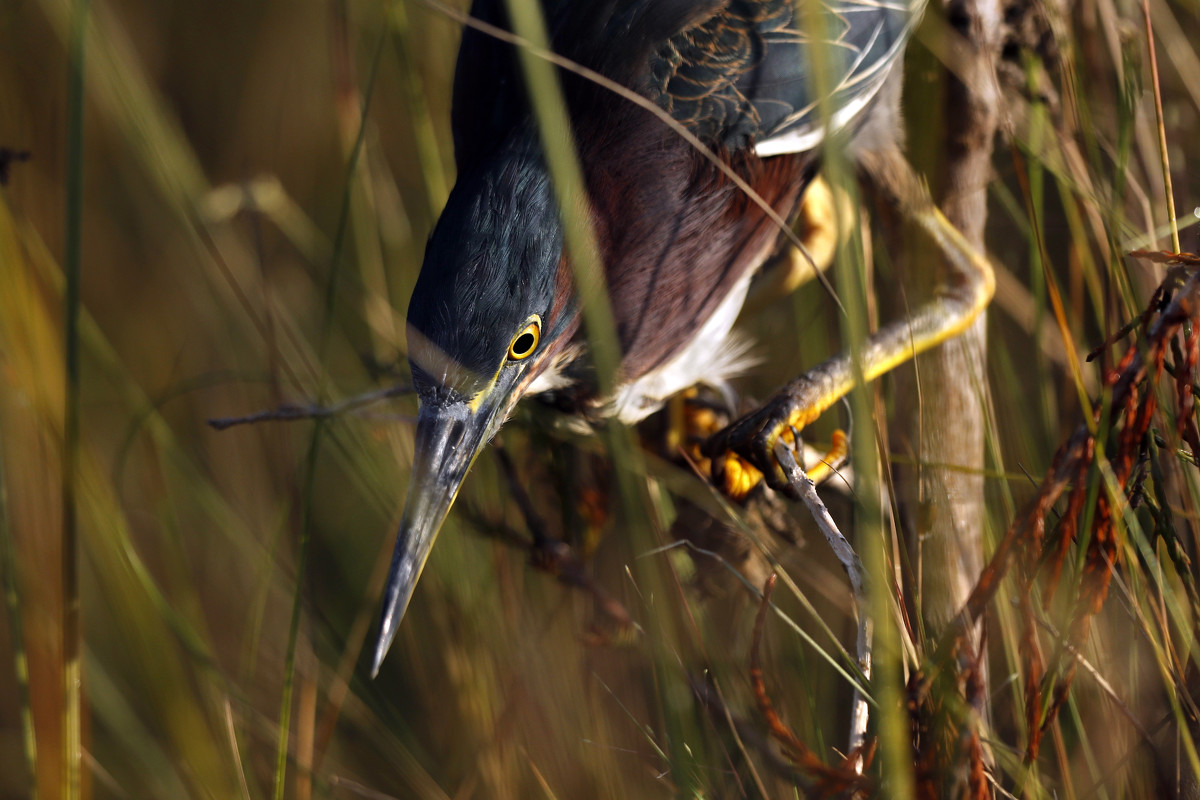
In this Friday, Oct. 18, 2019 photo, a green heron hunts for small fish in Everglades National Park, near Flamingo, Fla. (AP Photo/Robert F. Bukaty)
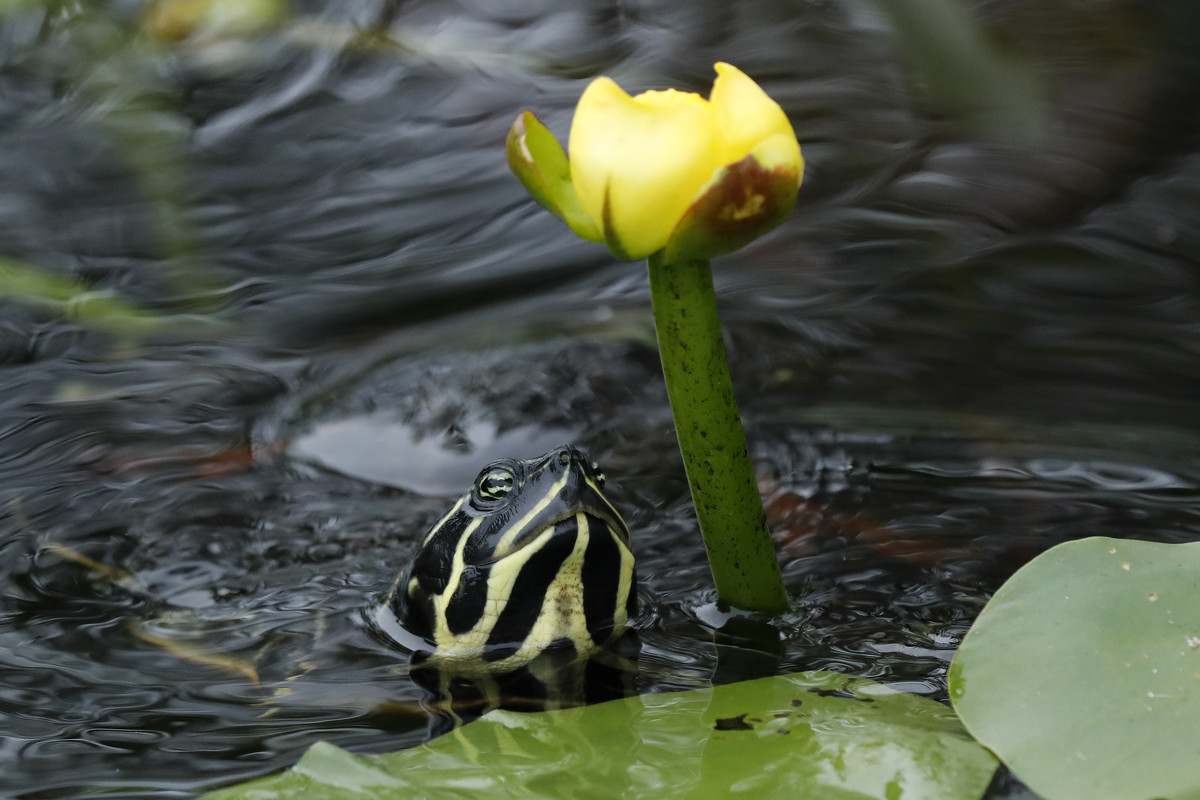
In this Friday, Oct. 18, 2019 photo, a Florida red-bellied turtle moves in to eat the flower of a lily pad in Everglades National Park, near Flamingo, Fla. (AP Photo/Robert F. Bukaty)
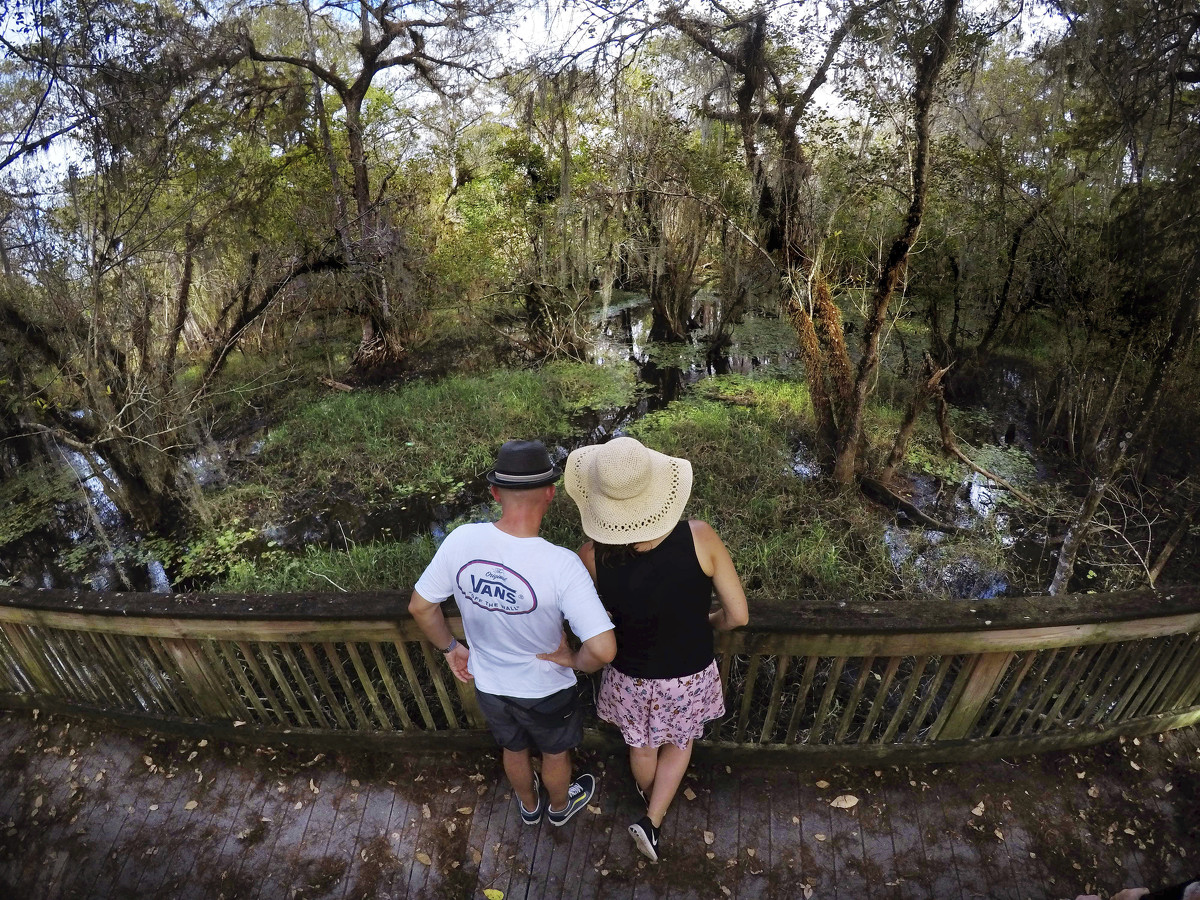
In this Sunday, Oct. 20, 2019 photo, visitors view the scenery and wildlife in the swamp at the Big Cypress National Preserve in Florida. (AP Photo/Robert F. Bukaty)
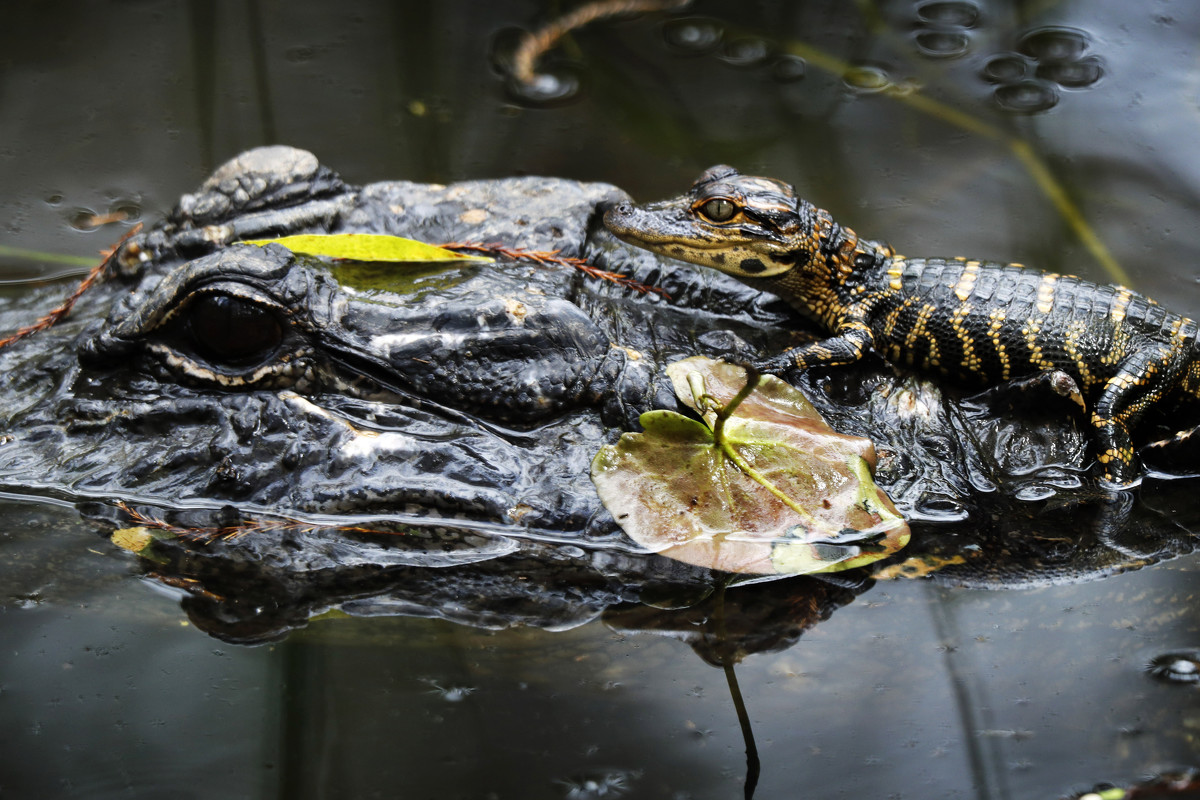
In this Sunday, Oct. 20, 2019 photo, a baby alligator rests atop an adult in a swamp at the Big Cypress National Preserve in Florida. (AP Photo/Robert F. Bukaty)
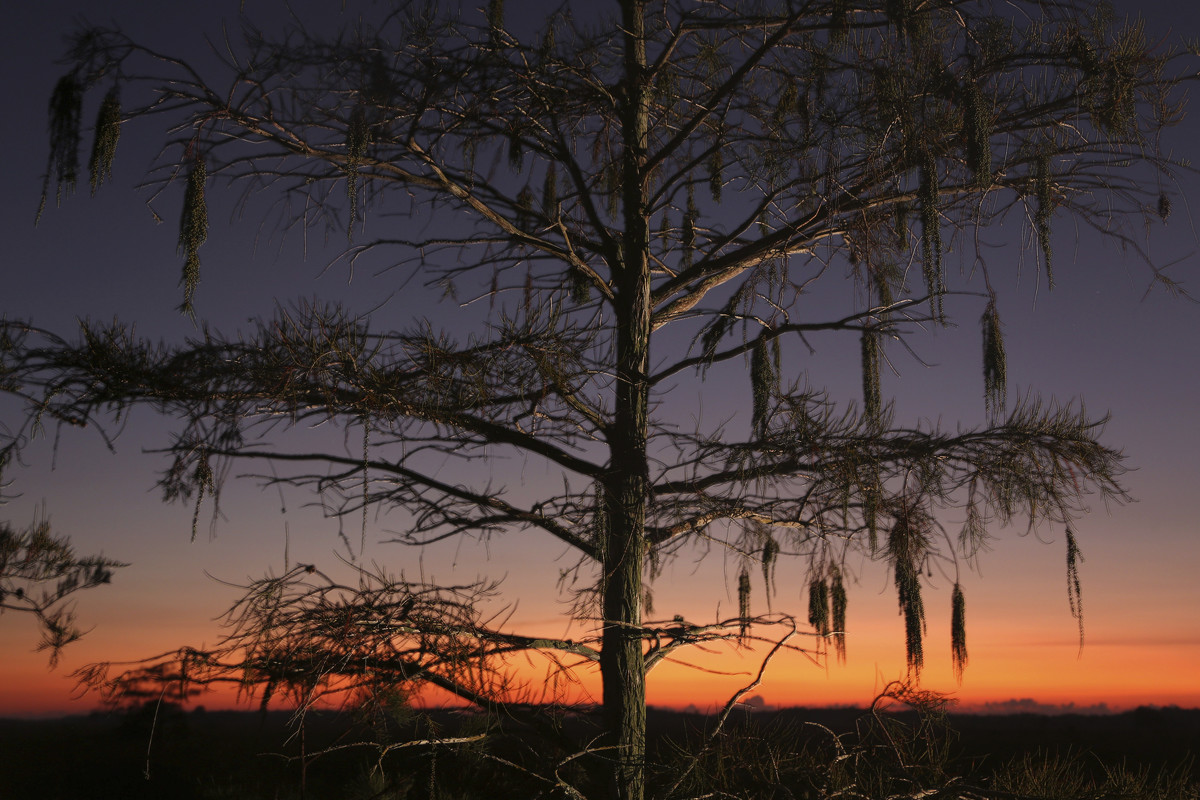
In this Monday, Oct. 21, 2019 photo a cypress tree is seen at dawn in Everglades National Park. (AP Photo/Robert F. Bukaty)
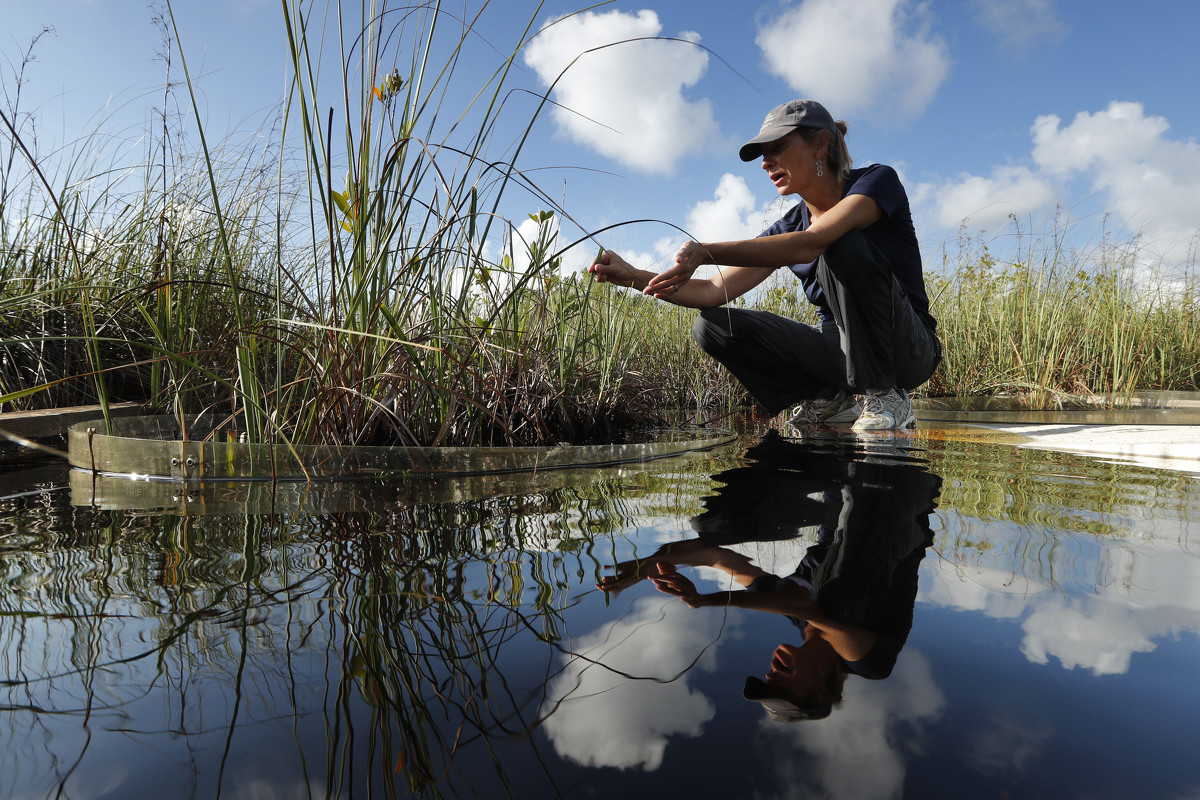
In this Monday, Oct. 21, 2019 photo, Tiffany Troxler, research scientist and professor at Florida International University walks on a boardwalk at a wetlands research site at Everglades National Park near Flamingo, Fla. She's studying wetlands ecosystem ands its relation to sea-level rise. (AP Photo/Robert F. Bukaty)
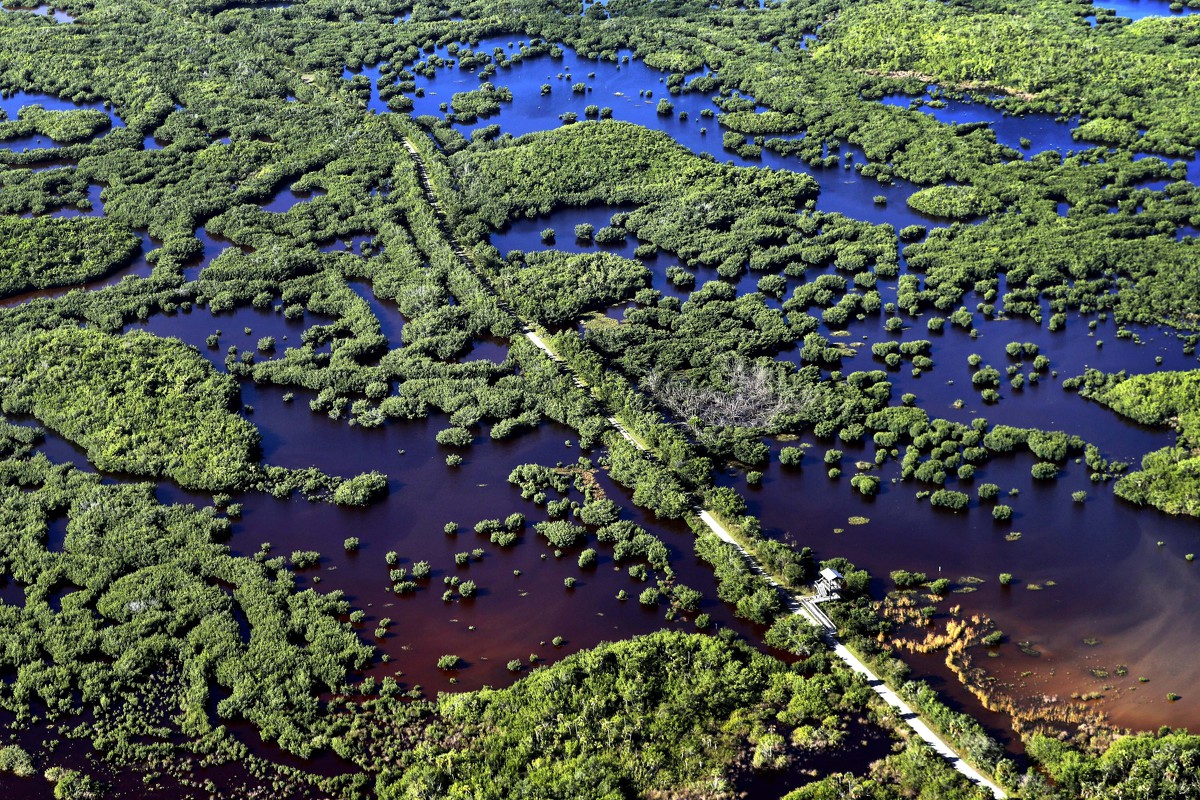
In this Thursday, Oct. 24, 2019, photo, the Marsh Trail bisects a section of the Ten Thousand Islands National Wildlife Refuge in the western Everglades near Naples, Fla. Clusters of mangroves form islands in a shallow estuary. A healthy mangrove forest is important for protecting coasts during storms. (AP Photo/Robert F. Bukaty)

In this Monday, Oct. 21, 2019 photo, a barred owl rests at dawn in Everglades National Park near Flamingo, Fla. (AP Photo/Robert F. Bukaty)
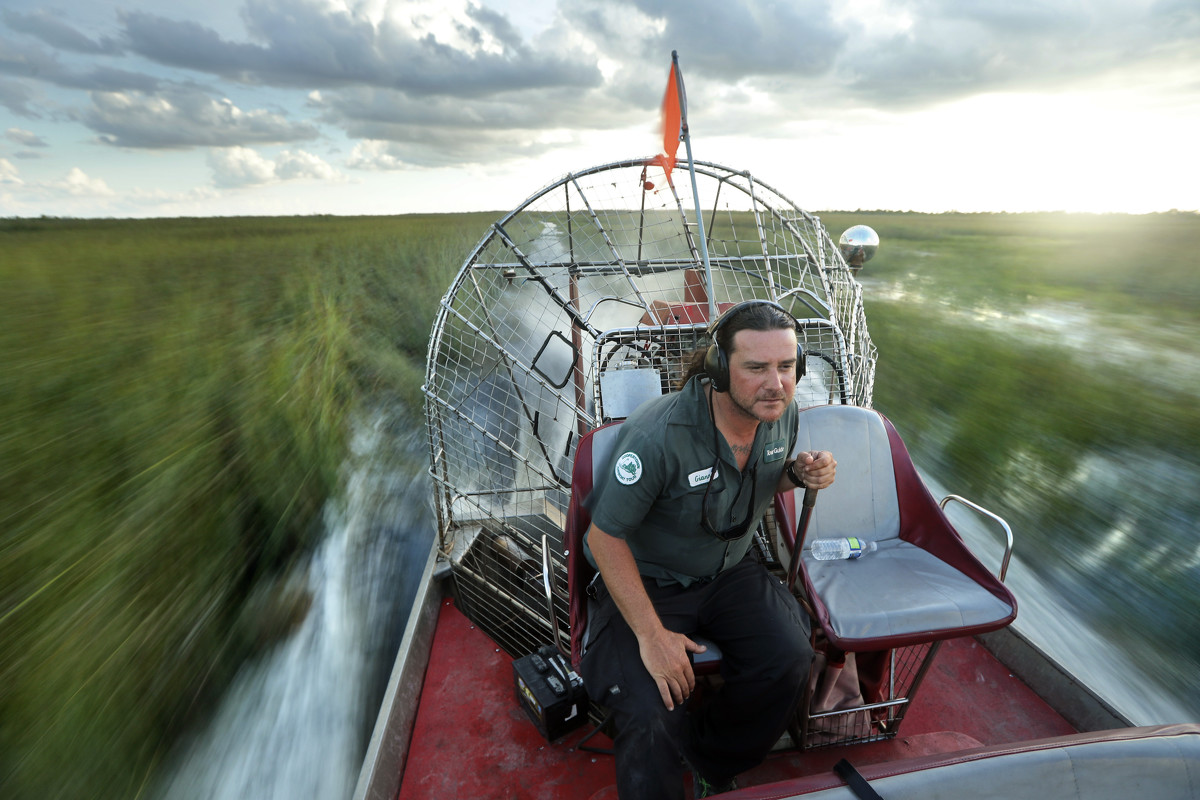
In this Tuesday, Oct. 22, 2019 photo, tour guide Gianni Magrini pilots an airboat across a sawgrass marsh in Everglades National Park. Margrini, whose livelihood depends on tourism, has been guiding in the park for 25 years. (AP Photo/Robert F. Bukaty)
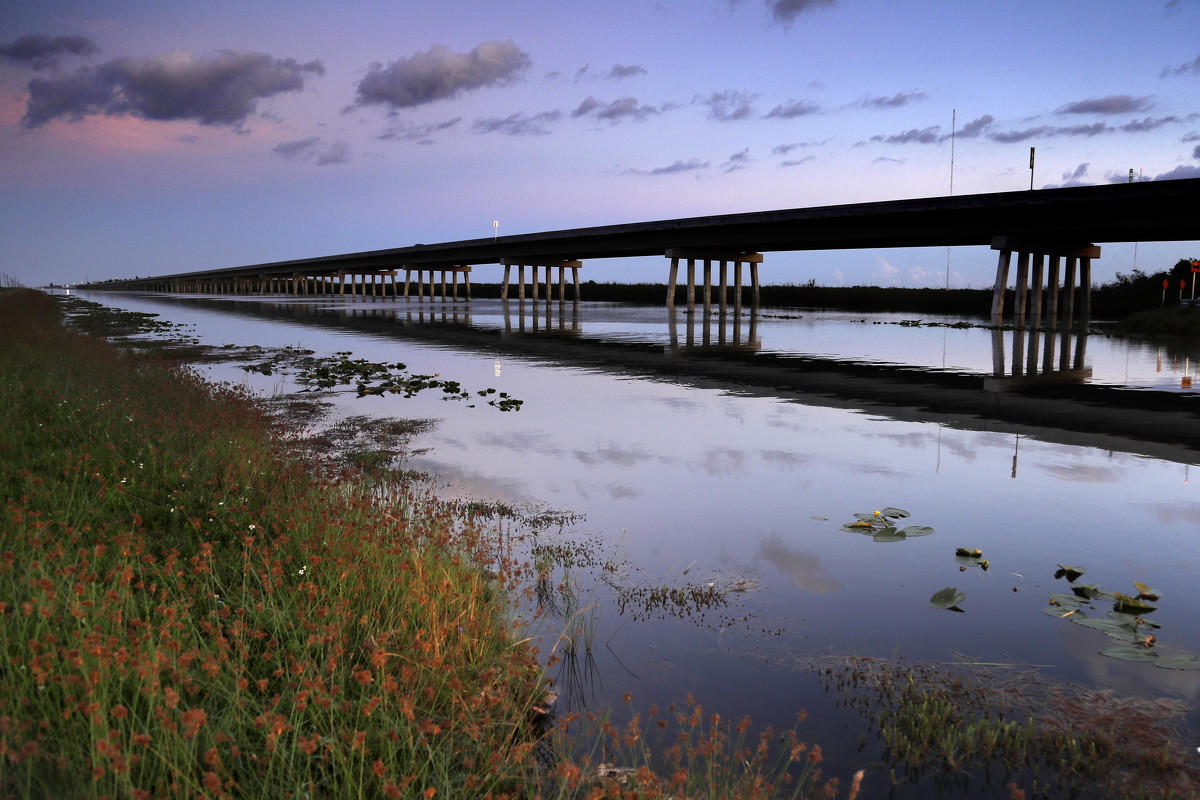
This Tuesday, Oct. 22, 2019 photo shows a raised portion of the Tamiami Trail, west of Miami, Fla. The 2.6-mile bridge, along with another 1-mile span, has helped move more water into Everglades National Park. Prior to 2013, the Tamiami Trail effectively served as a dike, cutting off the natural flow of water into the park. (AP Photo/Robert F. Bukaty)
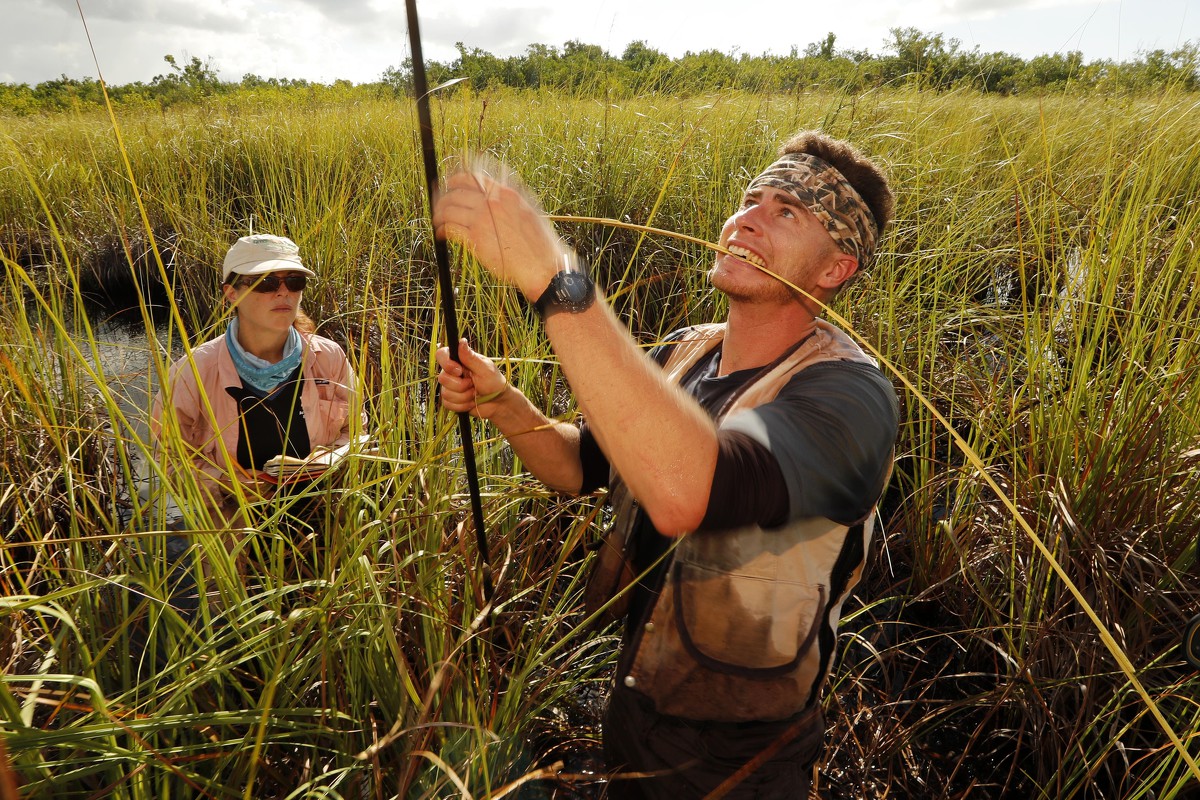
In this Wednesday, Oct. 30, 2019 photo, Lucas Lamb-Wooten, a PhD student at Florida International University, measures a blade of sawgrass during a research outing at Everglades National Park, near Flamingo, Fla. Lamb-Wooten is studying peat collapse in a coastal saw grass marshes. Research assistant Laura Bauman records data at left. (AP Photo/Robert F. Bukaty)
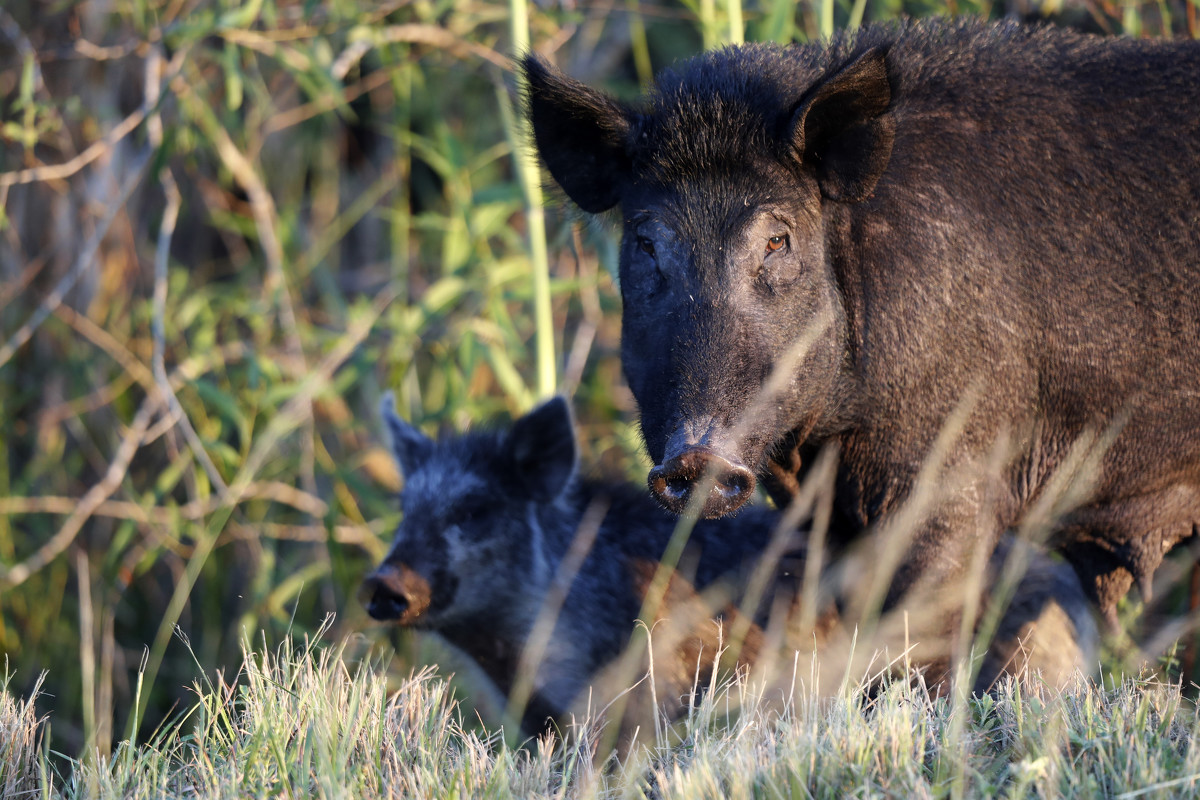
In this Friday, Oct. 25, 2019 photo, feral pigs roam near LaBelle, Fla. The state is second only to Texas in the number of non-native wild pigs living in the state. (AP Photo/Robert F. Bukaty)
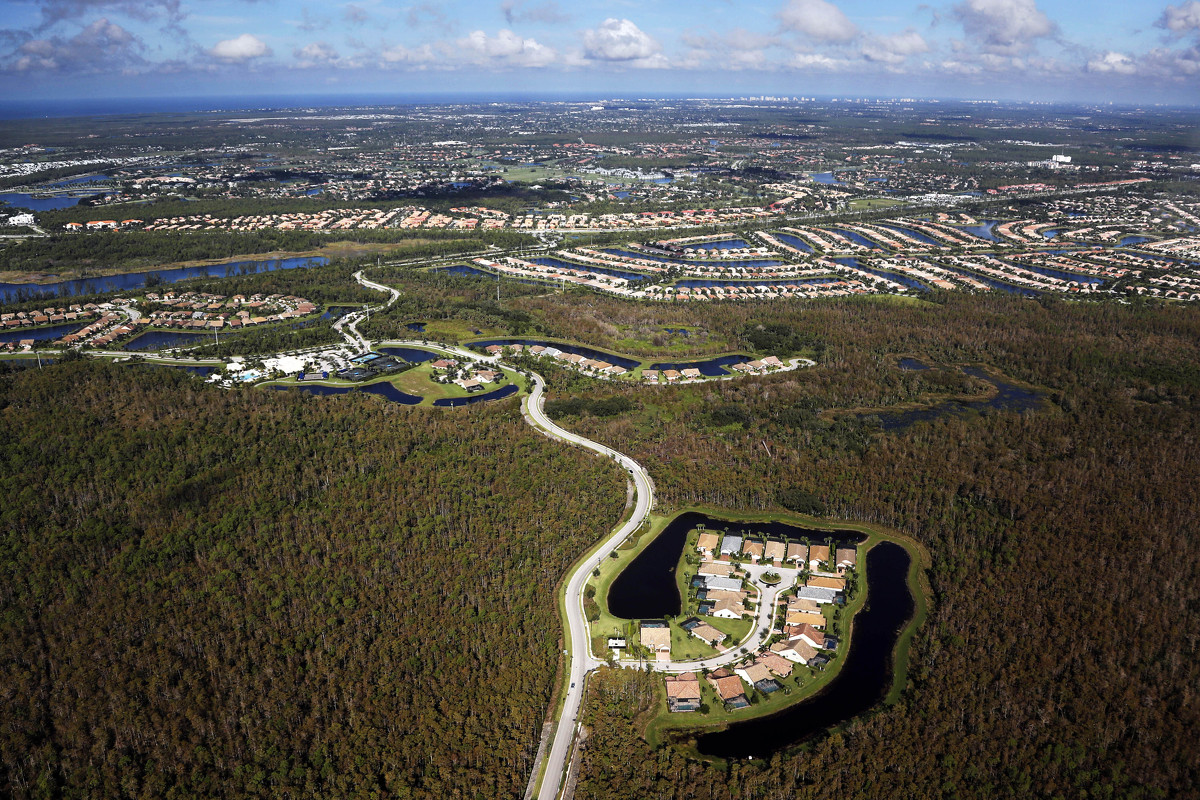
In this Thursday, Oct. 24, 2019, photo, a housing development built in Everglades wetlands is seen from the air near Naples, Florida. (AP Photo/Robert F. Bukaty)
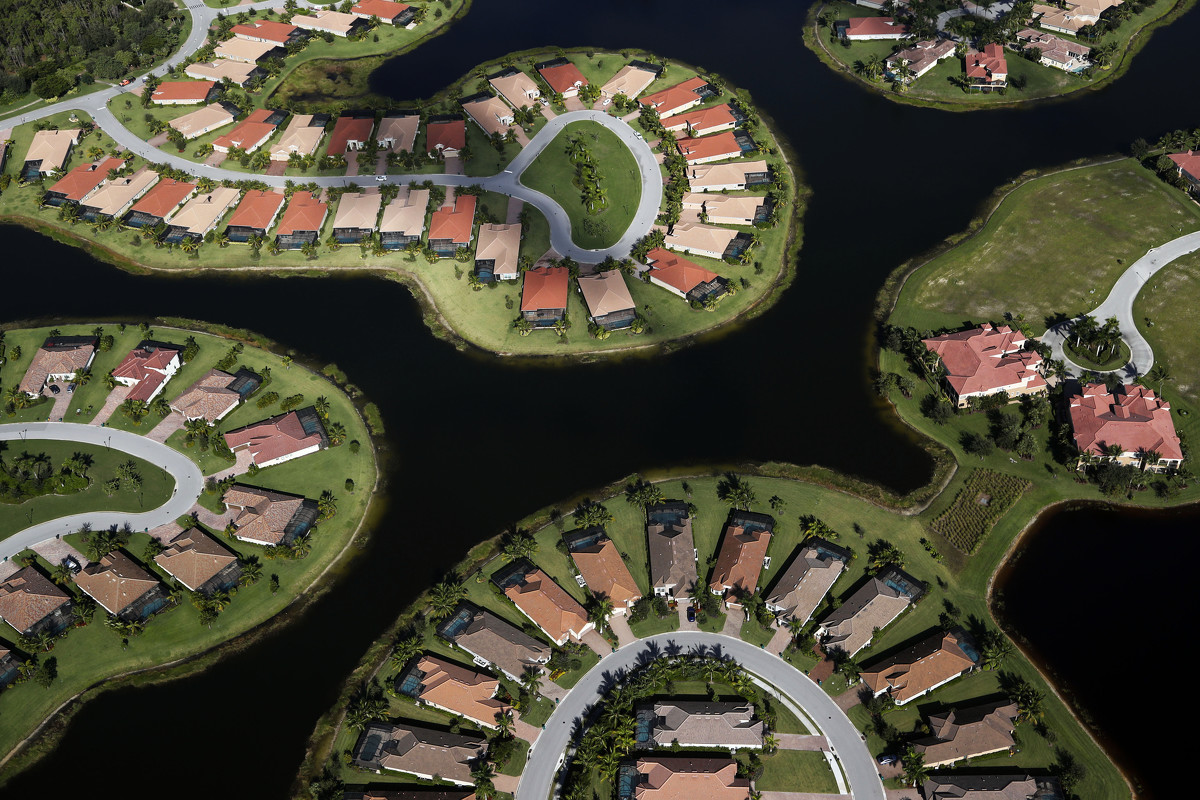
In this Thursday, Oct. 24, 2019, photo, a housing development built in Everglades wetlands is seen from the air near Naples, Fla. (AP Photo/Robert F. Bukaty)
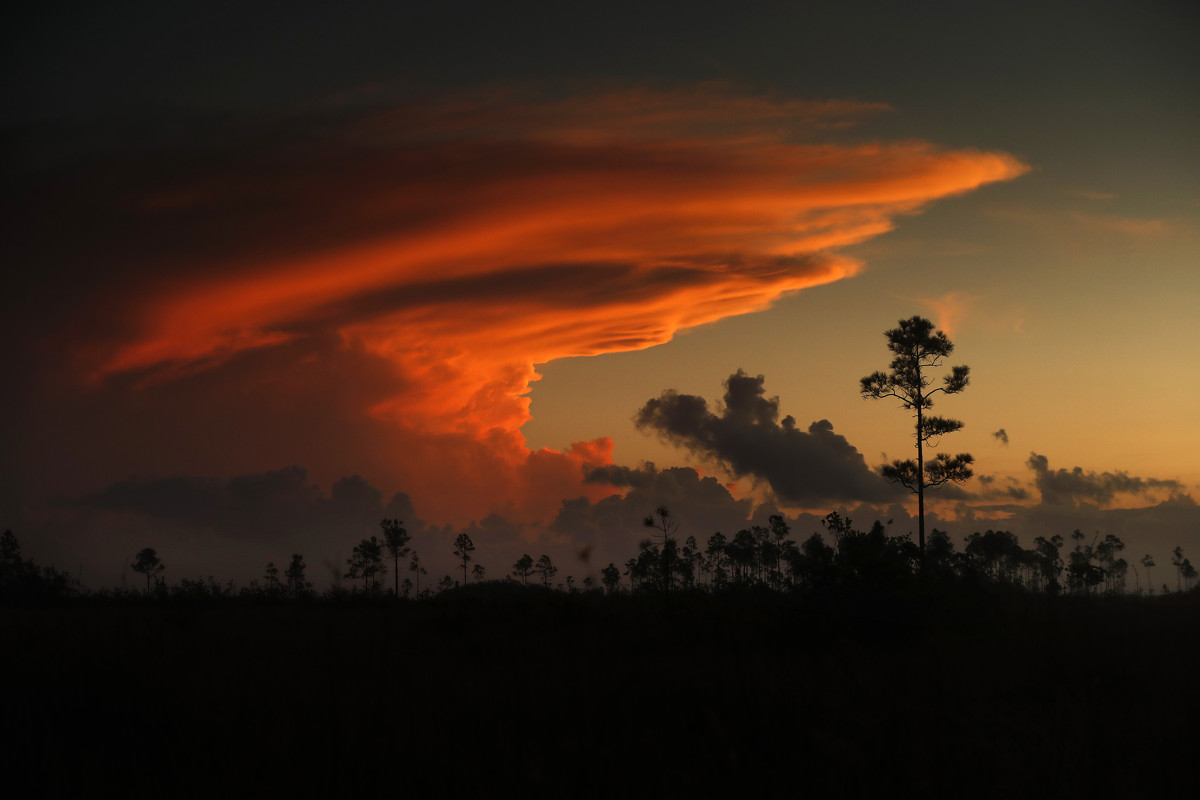
In this Tuesday, Oct. 22, 2019 photo, the first rays of sunlight color clouds over Everglades National Park, near Flamingo, Fla. The park receives nearly 60 inches of rain annually. "Here are no lofty peaks seeking the sky, no mighty glaciers or rushing streams wearing away the uplifted land," President Harry S. Truman said in a Dec. 6, 1947, address dedicating the Everglades National Park. "Here is land, tranquil in its quiet beauty, serving not as the source of water, but as the last receiver of it. To its natural abundance we owe the spectacular plant and animal life that distinguishes this place from all others in our country." (AP Photo/Robert F. Bukaty)
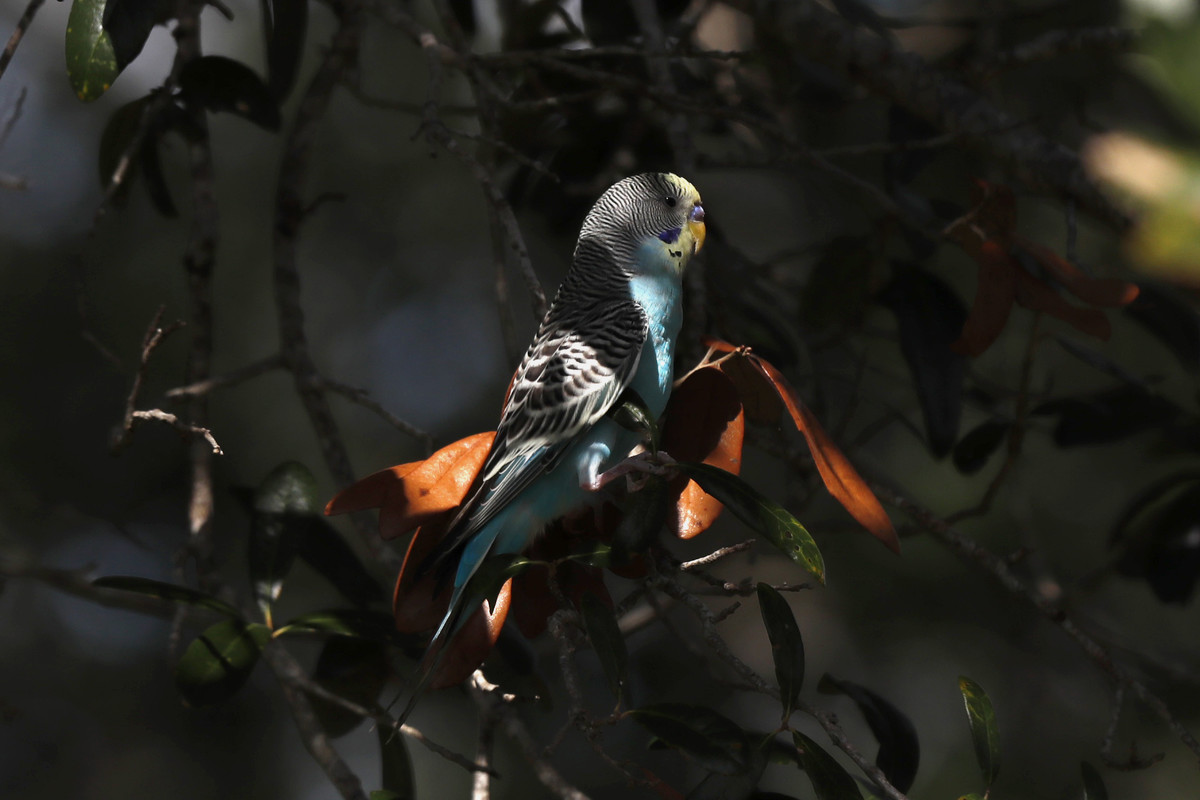
In this Friday, Oct. 25, 2019 photo, a yellow faced budgie, rests in a tree at the Wild Turkey Preserve Strand near Fort Myers, Fla. The non-native bird is one several species now living in the wild after being released by pet owners. (AP Photo/Robert F. Bukaty)
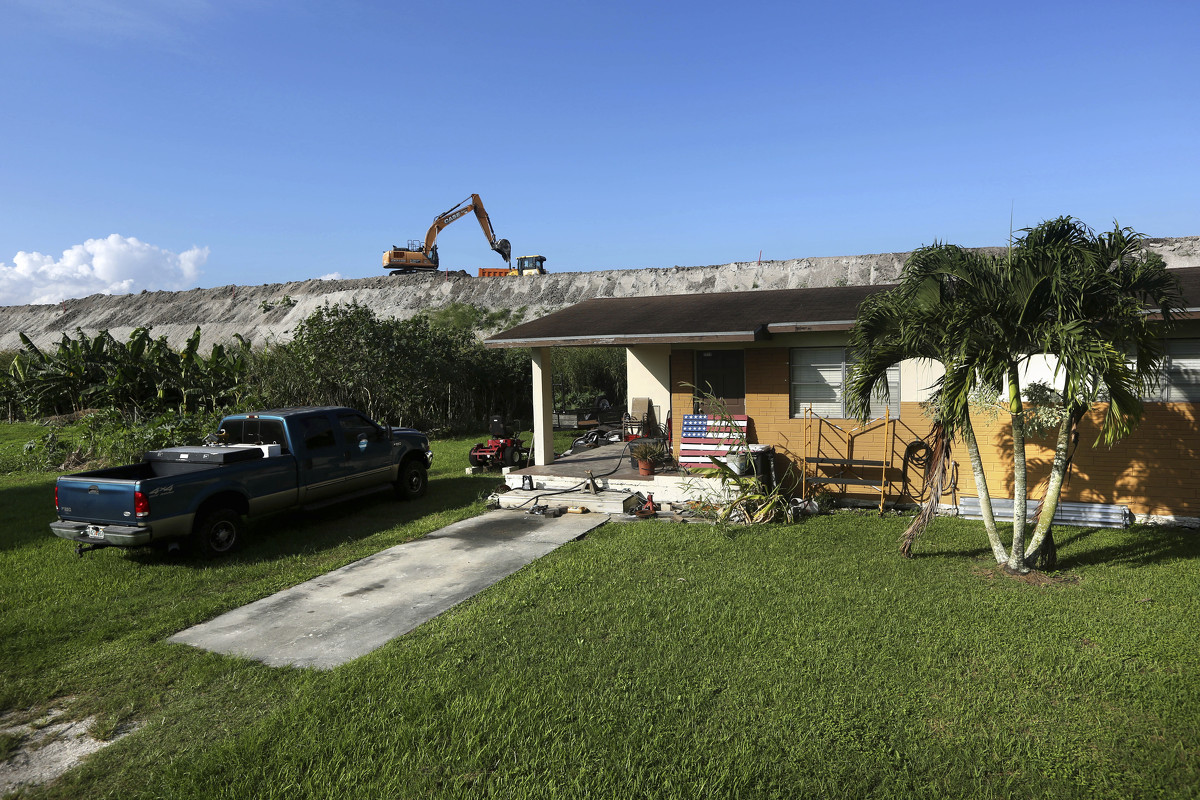
In this Friday, Nov. 1, 2019 photo, rehabilitation work takes place on top of the Herbert Hoover Dike surrounding Lake Okeechobee, just a few feet from a home in Pahokee, Fla. Hurricane tides overtopped the original dike in 1926 and 1928, washed away houses and caused over 2,500 deaths. (AP Photo/Robert F. Bukaty)

In this Friday, Oct. 25, 2019, photo, workers use heavy equipment to strengthen the 1930s-era Herbert Hoover Dike ringing Lake Okeechobee, at South Bay, Fla. (AP Photo/Robert F. Bukaty)
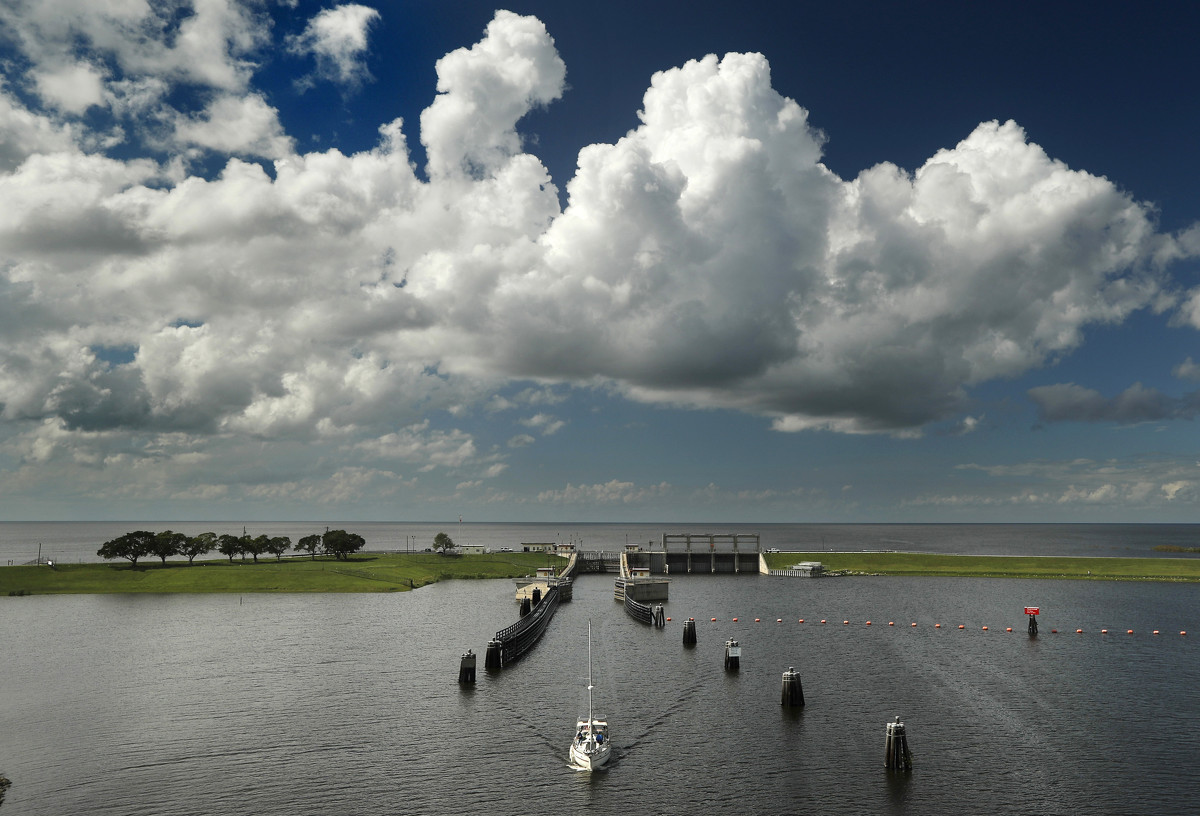
In this Friday, Oct. 25, 2019, photo, a sailboat starts down the St. Lucie Canal after leaving Lake Okeechobee, background, through the Port Mayaca, Fla., lock north of Belle Glade, Fla. The lock and dam was built in 1977 to raise the water level in the lake and provide flood control. (AP Photo/Robert F. Bukaty)
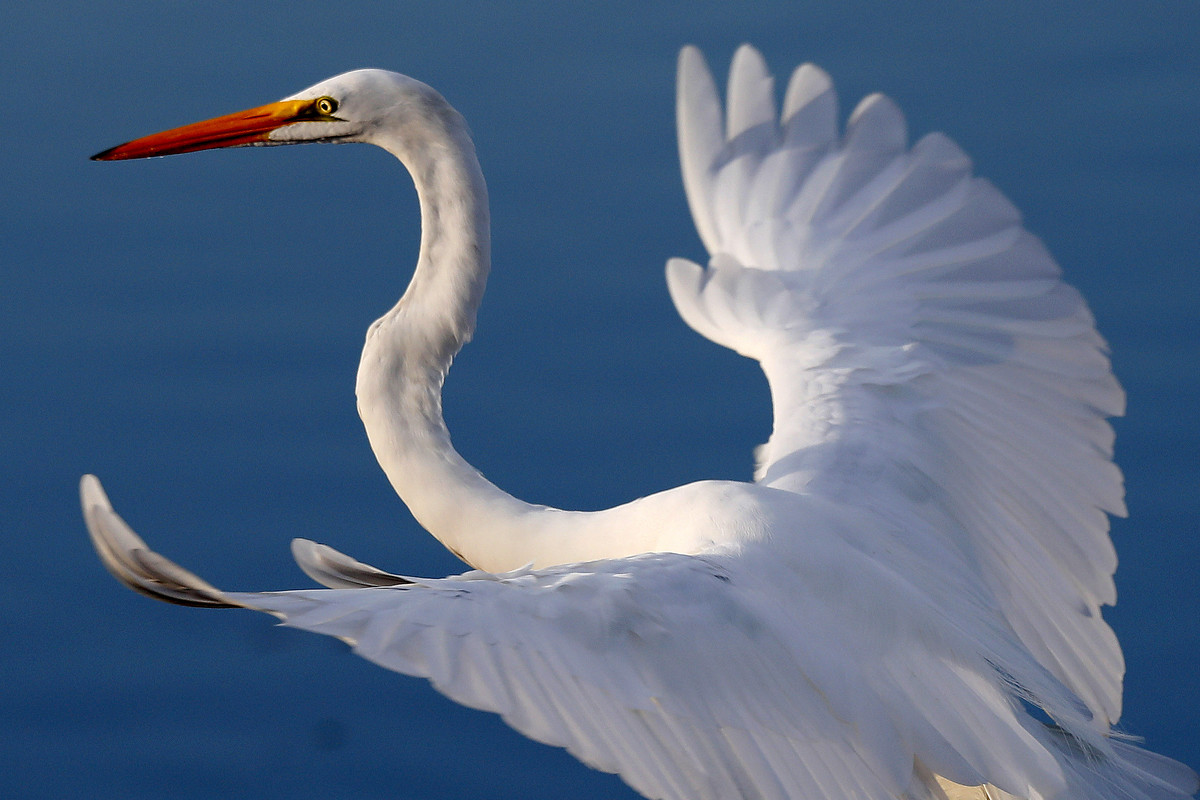
In this Friday, Nov. 1, 2019 photo a great egret takes flight at Lake Okeechobee in Clewiston, Fla. (AP Photo/Robert F. Bukaty)
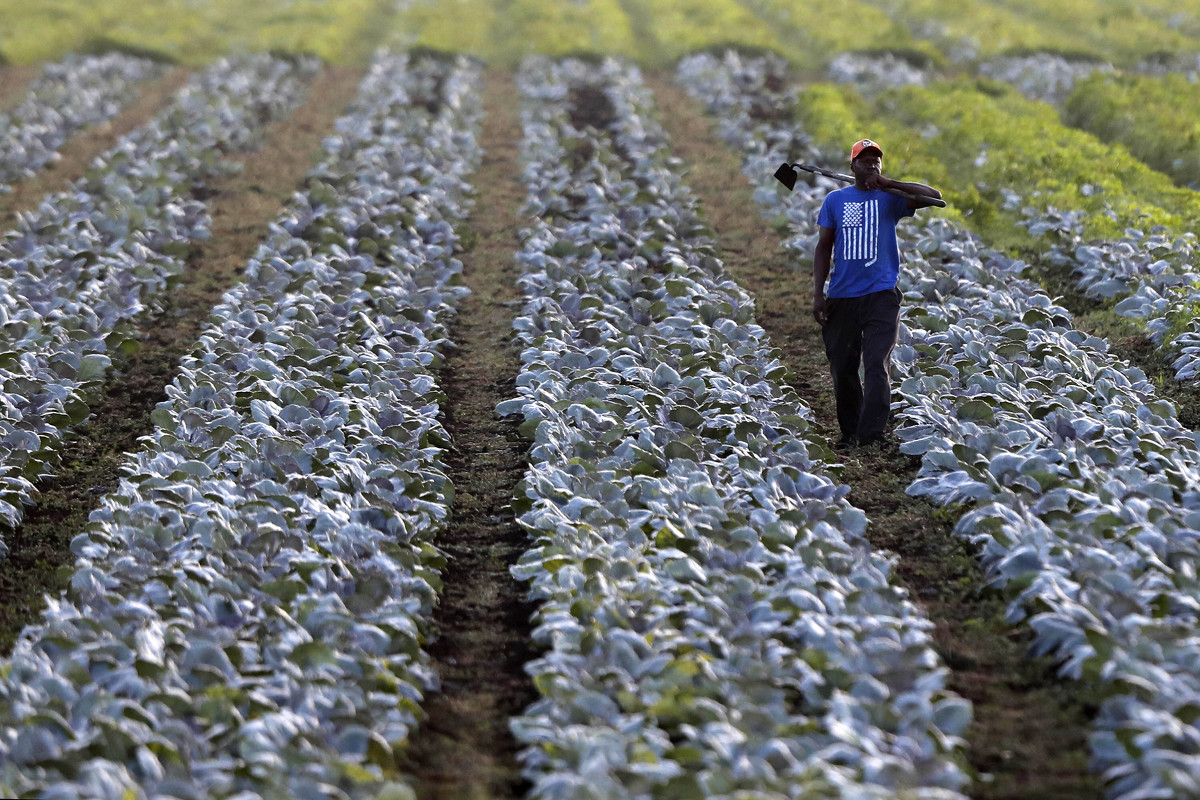
In this Friday, Nov. 1, 2019 photo, a worker arrives to hoe a vegetable farm near Belle Glade, Fla. Much of the original everglades ecosystem has been drained to create farm land. (AP Photo/Robert F. Bukaty)
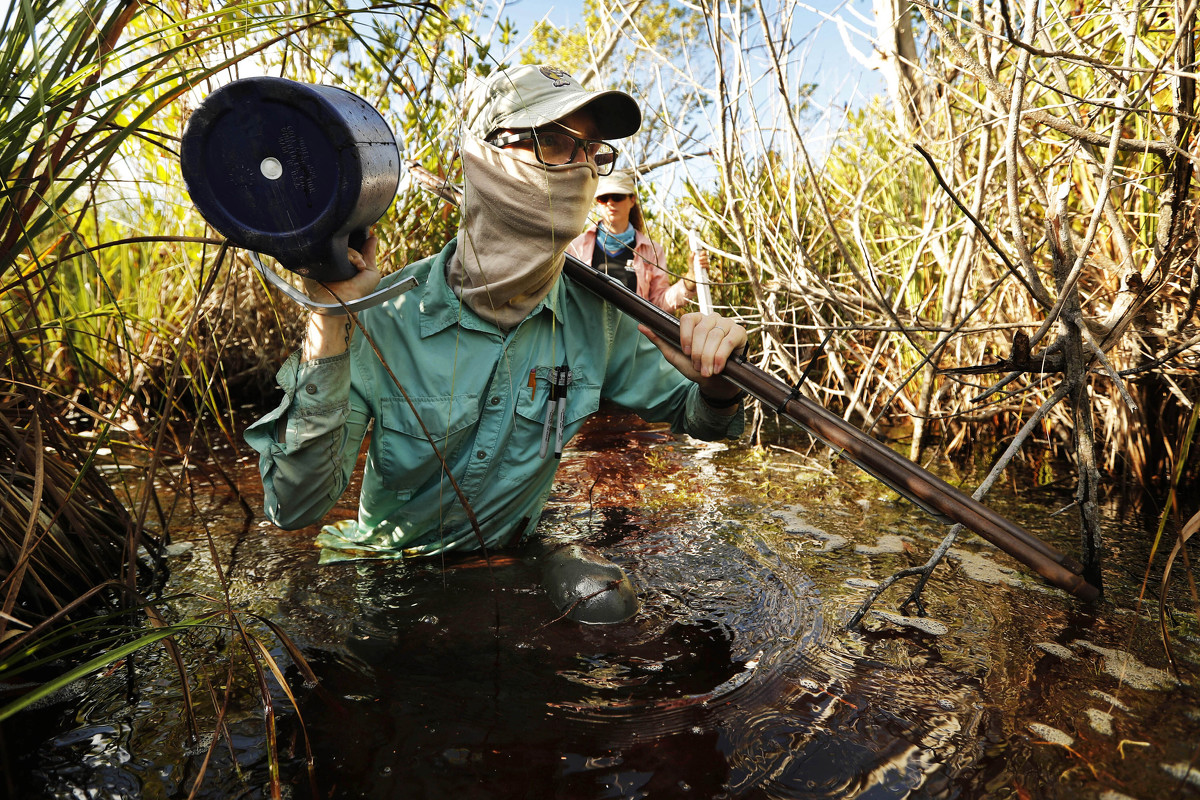
In this Wednesday, Oct. 30, 2019 photo, Austin Pezoldt carries gear through mucky water while assisting in a study of peat collapse in a coastal saw grass marsh at Everglades National Park, Fla. (AP Photo/Robert F. Bukaty)
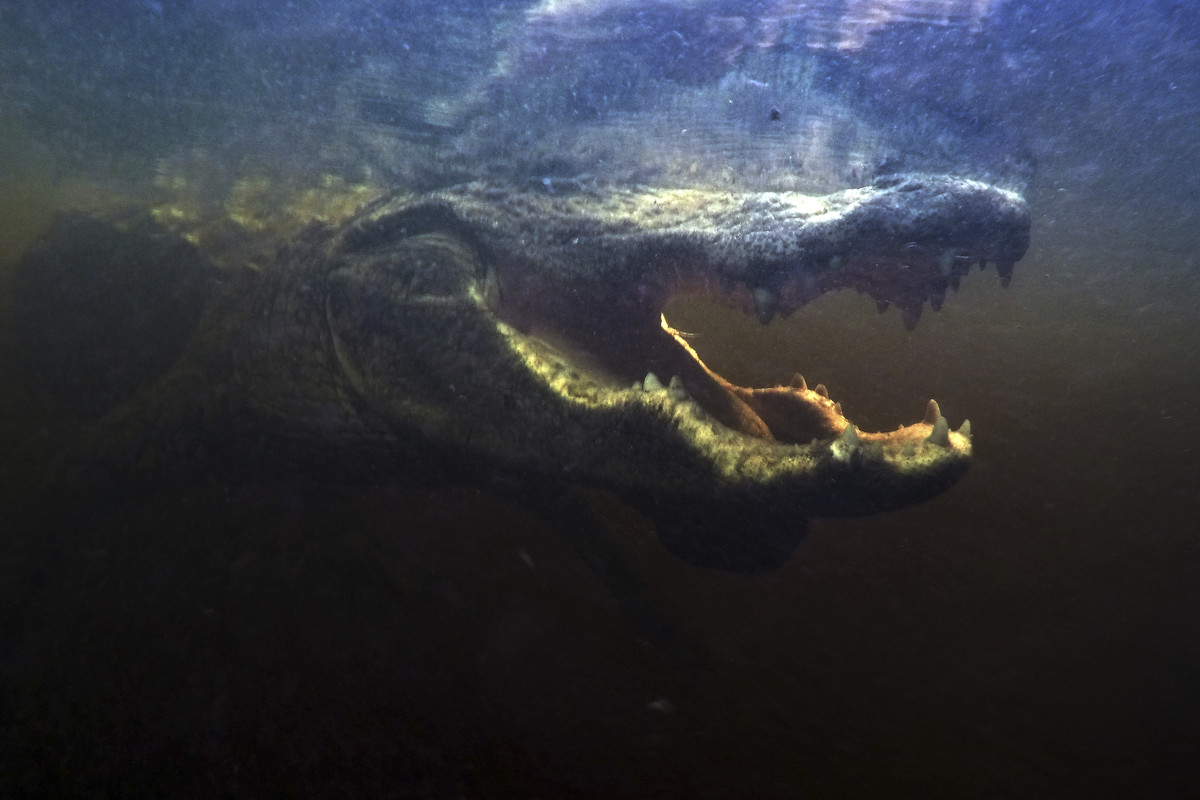
In this Tuesday, Oct. 22, 2019 photo, an alligator prowls Everglades National Park in search of a meal. (AP Photo/Robert F. Bukaty)
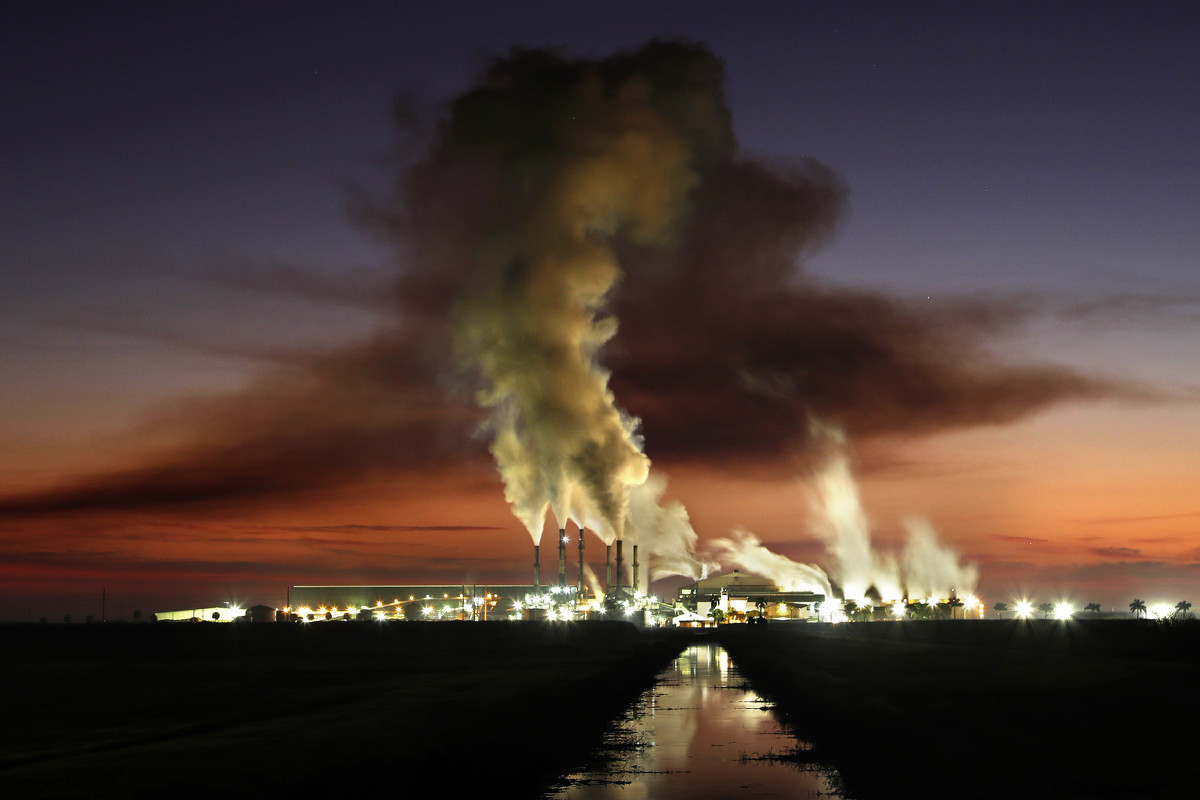
In this Friday, Nov. 1, 2019 photo, the Sugar Cane Cooperative's mill processes sugar cane at dawn in Belle Glade, Fla. The mill operates 24-hours a day during the harvest season, grinding as much as 26,000 tons of sugarcane per day. (AP Photo/Robert F. Bukaty)
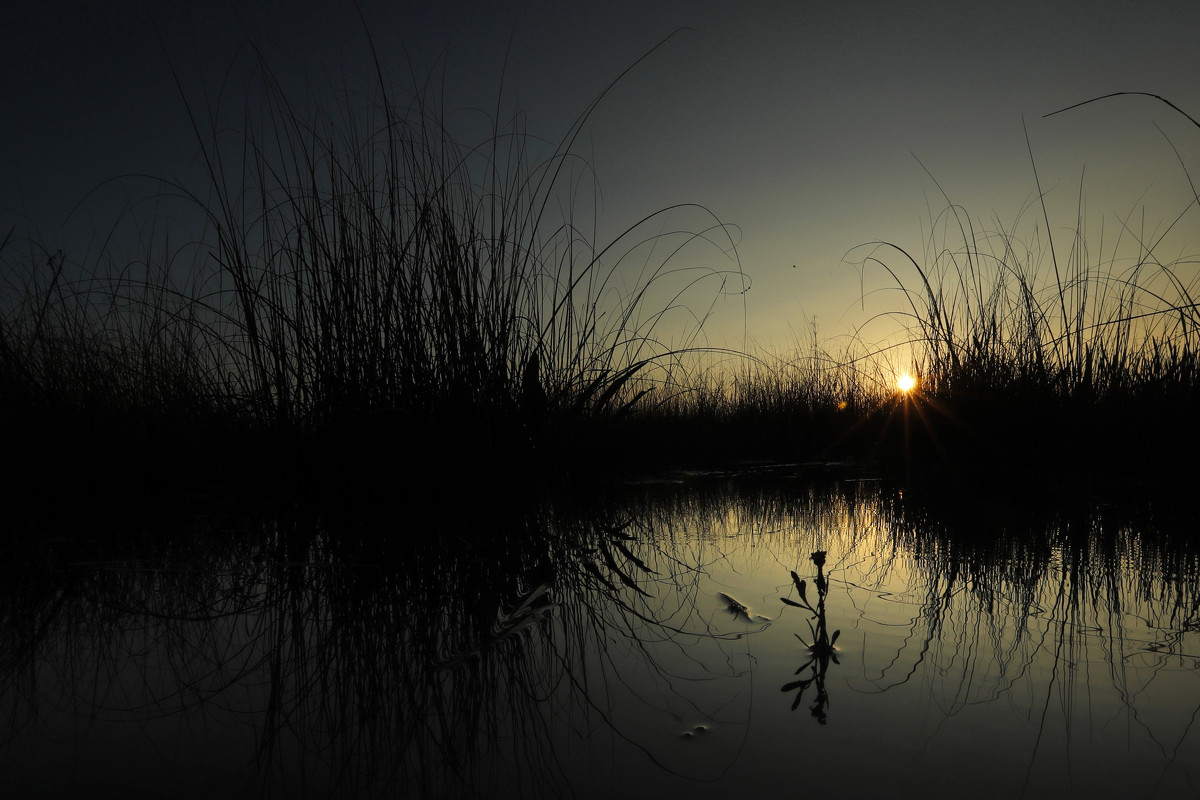
In this Monday, Oct. 21, 2019 photo, the sun rises behind saw grass in a marsh at Everglades National Park near Flamingo, Fla. "Here are no lofty peaks seeking the sky, no mighty glaciers or rushing streams wearing away the uplifted land," President Harry S. Truman said in a Dec. 6, 1947, address dedicating the Everglades National Park. "Here is land, tranquil in its quiet beauty, serving not as the source of water, but as the last receiver of it. To its natural abundance we owe the spectacular plant and animal life that distinguishes this place from all others in our country." (AP Photo/Robert F. Bukaty)
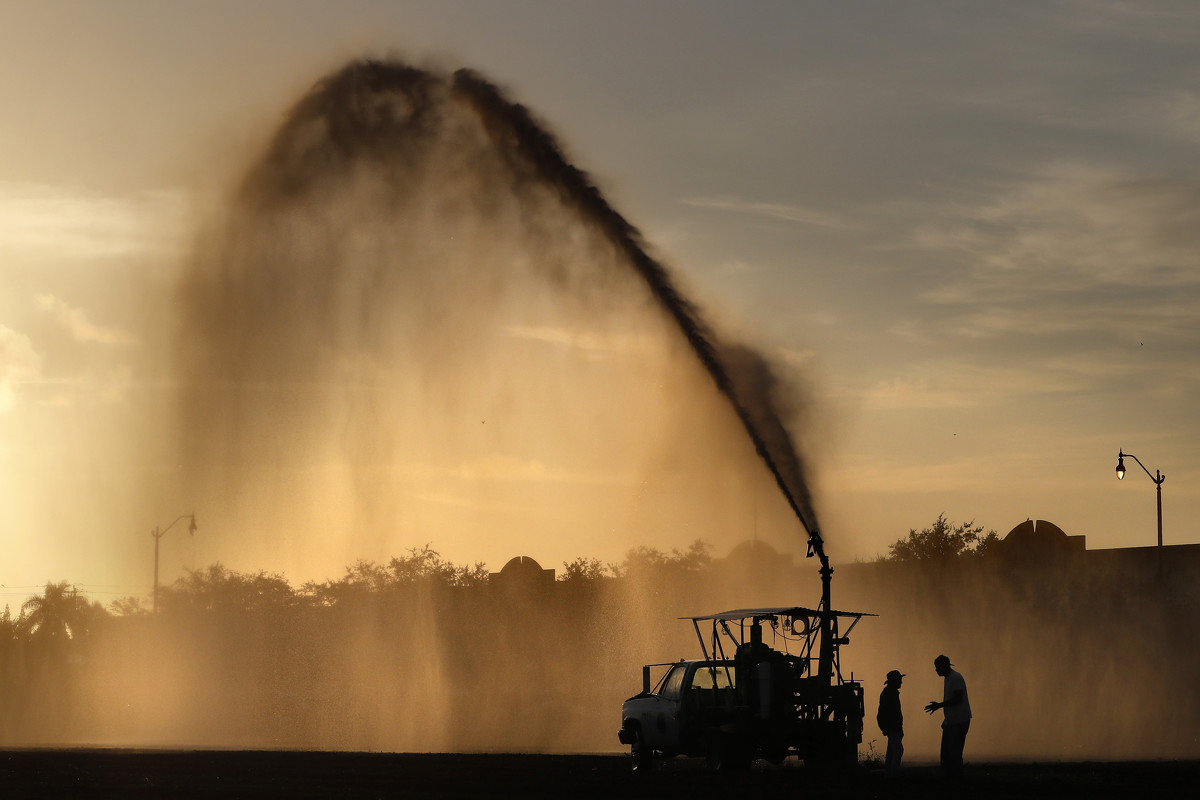
In this Monday, Oct. 28 2019, photo, a farm is watered in Florida City, Fla, just east of the main entrance to Everglades National Park. Early settlers and developers dredged and drained much of the ecosystem for agriculture. (AP Photo/Robert F. Bukaty)
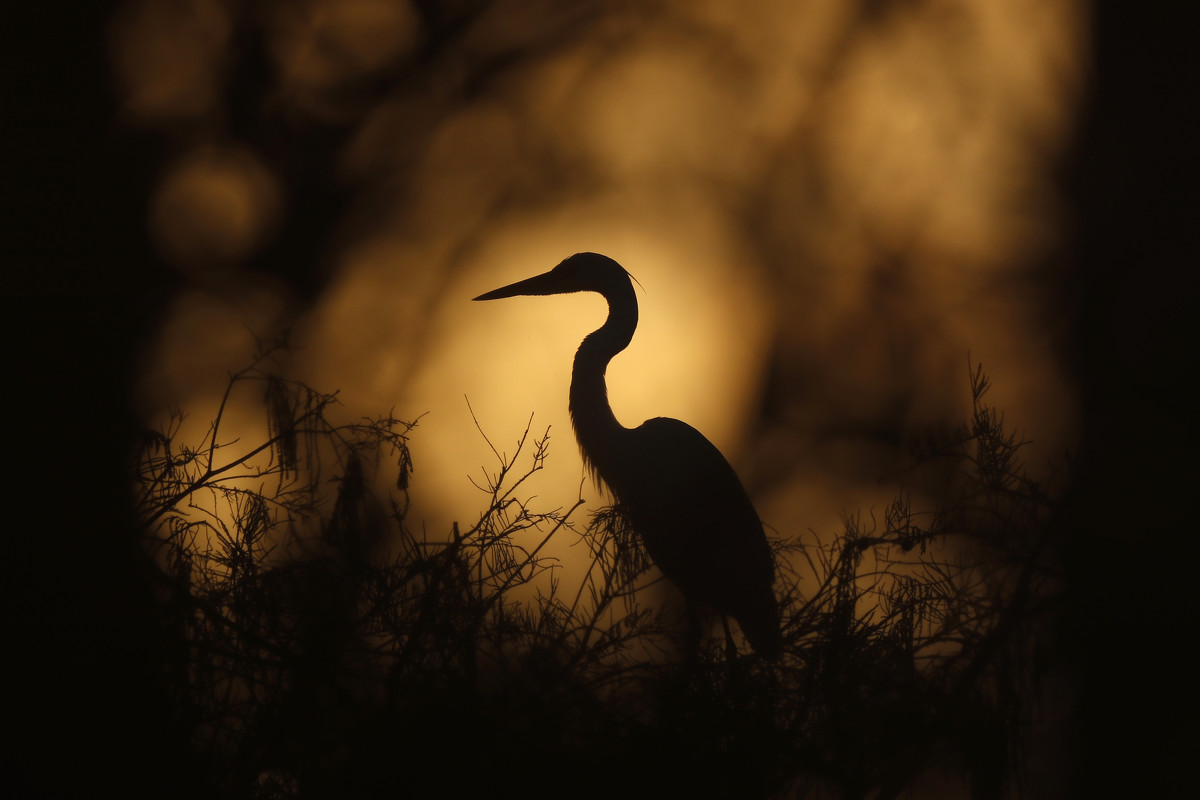
In this Friday, Oct. 18, 2019 photo, a great egret is seen on top of a tree at dawn in Everglades National Park, near Flamingo, Fla. (AP Photo/Robert F. Bukaty)